- Did You Know?
- Photo Gallery

ROSA LOUISE PARKS BIOGRAPHY
Rosa Louise Parks was nationally recognized as the “mother of the modern day civil rights movement” in America. Her refusal to surrender her seat to a white male passenger on a Montgomery, Alabama bus, December 1, 1955, triggered a wave of protest December 5, 1955 that reverberated throughout the United States. Her quiet courageous act changed America, its view of black people and redirected the course of history.
Mrs. Parks was born Rosa Louise McCauley, February 4, 1913 in Tuskegee, Alabama. She was the first child of James and Leona Edwards McCauley. Her brother, Sylvester McCauley, now deceased, was born August 20, 1915. Later, the family moved to Pine Level, Alabama where Rosa was reared and educated in the rural school. When she completed her education in Pine Level at age eleven, her mother, Leona, enrolled her in Montgomery Industrial School for Girls (Miss White’s School for Girls), a private institution. After finishing Miss White’s School, she went on to Alabama State Teacher’s College High School. She, however, was unable to graduate with her class, because of the illness of her grandmother Rose Edwards and later her death.
As Rosa Parks prepared to return to Alabama State Teacher’s College, her mother also became ill, therefore, she continued to take care of their home and care for her mother while her brother, Sylvester, worked outside of the home. She received her high school diploma in 1934, after her marriage to Raymond Parks, December 18, 1932. Raymond, now deceased was born in Wedowee, Alabama, Randolph County, February 12, 1903, received little formal education due to racial segregation. He was a self-educated person with the assistance of his mother, Geri Parks. His immaculate dress and his thorough knowledge of domestic affairs and current events made most think he was college educated. He supported and encouraged Rosa’s desire to complete her formal education.
Mr. Parks was an early activist in the effort to free the “Scottsboro Boys,” a celebrated case in the 1930′s. Together, Raymond and Rosa worked in the National Association for the Advancement of Colored People (NAACP’s) programs. He was an active member and she served as secretary and later youth leader of the local branch. At the time of her arrest, she was preparing for a major youth conference.
After the arrest of Rosa Parks, black people of Montgomery and sympathizers of other races organized and promoted a boycott of the city bus line that lasted 381 days. Dr. Martin Luther King, Jr. was appointed the spokesperson for the Bus Boycott and taught nonviolence to all participants. Contingent with the protest in Montgomery, others took shape throughout the south and the country. They took form as sit-ins, eat-ins, swim-ins, and similar causes. Thousands of courageous people joined the “protest” to demand equal rights for all people.
Mrs. Parks moved to Detroit, Michigan in 1957. In 1964 she became a deaconess in the African Methodist Episcopal Church (AME).
Congressman John Conyers First Congressional District of Michigan employed Mrs. Parks, from 1965 to 1988. In February, 1987, she co-founded the Rosa and Raymond Parks Institute for Self Development with Ms. Elaine Eason Steele in honor of her husband, Raymond (1903-1977). The purpose is to motivate and direct youth not targeted by other programs to achieve their highest potential. Rosa Parks sees the energy of young people as a real force for change. It is among her most treasured themes of human priorities as she speaks to young people of all ages at schools, colleges, and national organizations around the world.
The Rosa and Raymond Parks Institute for Self Development’s “Pathways to Freedom program, traces the underground railroad into the civil rights movement and beyond. Youth, ages 11 through 17, meet and talk with Mrs. Parks and other national leaders as they participate in educational and historical research throughout the world. They journey primarily by bus as “freedom riders” did in the 1960′s,the theme: “Where have we been? Where are we going?”
As a role model for youth she was stimulated by their enthusiasm to learn as much about her life as possible. A modest person, she always encourages them to research the lives of other contributors to world peace. The Institute and The Rosa Parks Legacy are her legacies to people of good will.
Mrs. Parks received more than forty-three honorary doctorate degrees, including one from SOKA UNIVERSITY, Tokyo Japan, hundreds of plaques, certificates, citations, awards and keys to many cities. Among them are the NAACP’s Spingarn Medal, the UAW’s Social Justice Award, the Martin Luther King, Jr. Non – Violent Peace Prize and the ROSA PARKS PEACE PRIZE in 1994, Stockholm Sweden, to name a few. In September 1996 President William J. Clinton, the forty second President of the United States of America gave Mrs. Parks the MEDAL OF FREEDOM, the highest award given to a civilian citizen.
Published Act no.28 of 1997 designated the first Monday following February 4, as Mrs Rosa Parks’ Day in the state of Michigan, her home state. She is the first living person to be honored with a holiday.
She was voted by Time Magazine as one of the 100 most Influential people of the 20th century. A Museum and Library is being built in her honor, in Montgomery, AL and will open in the fall of the year 2000 (ground breaking April 21, 1998). On September 2, 1998 The Rosa L. Parks Learning Center was dedicated at Botsford Commons, a senior community in Michigan. Through the use of computer technology, youth will mentor seniors on the use of computers. (Mrs. Parks was a member of the first graduating class on November 24, 1998). On September 26, 1998 Mrs. Parks was the recipient of the first International Freedom Conductor’s Award by the National Underground Railroad Freedom Center in Cincinnati, Ohio.
She attended her first “State of the Union Address” in January 1999. Mrs. Parks received a unanimous bipartisan standing ovation when President William Jefferson Clinton acknowledged her. Representative Julia Carson of Indianapolis, Indiana introduced H. R. Bill 573 on February 4, 1999, which would award Mrs. Rosa Parks the Congressional Gold Medal of Honor if it passed the House of Representatives and the Senate by a majority. The bill was passed unanimously in the Senate on April 19, and with one descenting vote in the House of Representatives on April 20. President Clinton signed it into law on May 3, 1999. Mrs. Parks was one of only 250 individuals at the time, including the American Red Cross to receive this honor. President George Washington was the first to receive the Congressional Gold Medal of Honor. President Nelson Mandela is also listed among the select few of world leaders who have received the medal.
In the winter of 2000 Mrs. Parks met Pope John-Paul II in St. Louis, MO and read a statement to him asking for racial healing. She received the NAACP Image Award for Best Supporting Actress in the Television series, TOUCHED BY AN ANGEL, “Black like Monica”. Troy State University at Montgomery opened The Rosa Parks Library and Museum on the site where Mrs. Parks was arrested December 1, 1955. It opened on the 45th Anniversary of her arrest and the Montgomery Bus Boycott.
“The Rosa Parks Story” was filmed in Montgomery, Alabama May 2001, an aired February 24, 2002 on the CBS television network. Mrs. Parks continues to receive numerous awards including the very first Lifetime Achievement Award ever given by The Institute for Research on Women & Gender, Stanford University. She received the Gandhi, King, Ikeda award for peace and on October 29, 2003 Mrs. Parks was an International Institute Heritage Hall of fame honoree. On February 4, 2004 Mrs. Parks 91st birthday was celebrated at the Charles H. Wright Museum of African American History. On December 21, 2004 the 49th Anniversary of the Mrs. Parks’ arrest was commemorated with a Civil Rights and Hip-Hop Forum at the Franklin Settlement in Detroit, Michigan.
On February 4, 2005 Mrs. Parks’ 92nd birthday was celebrate at Calvary Baptist Church in Detroit, MI. Students from the Detroit Public Schools did “Willing to be Arrested,” a reenactment of Mrs. Parks arrest. February 6, 2005 Mrs. Parks received the first annual Cardinal Dearden Peace Award at Holy Trinity Catholic Church in Detroit, MI. February 19 – 20, composer Hannibal Lokumbe premiered an original symphony “Dear Mrs. Parks.” Mr. Lokumbe did this original work as part of the Detroit Symphony Orchestra’s ” Classical Roots Series.” The beginning of many events that will commemorate the 50th Anniversary of Mrs. Parks’ arrest December 1, 1955.
Mrs. Parks has written four books, Rosa Parks: My Story: by Rosa Parks with Jim Haskins, Quiet Strength by Rosa Parks with Gregory J. Reed, Dear Mrs. Parks: A Dialogue With Today’s Youth by Rosa Parks with Gregory J, Reed, this book received the NAACP’s Image Award for Outstanding Literary Work, (Children’s) in 1996 and her latest book, I AM ROSA PARKS by Rosa Parks with Jim Haskins, for preschoolers.
A quiet exemplification of courage, dignity, and determination; Rosa Parks was a symbol to all to remain free. Rosa Parks made her peaceful transition October 24, 2005.
Find Us On Facebook
REACH THE INSTITUTE
Rosa parks institute for self development.
- History Classics
- Your Profile
- Find History on Facebook (Opens in a new window)
- Find History on Twitter (Opens in a new window)
- Find History on YouTube (Opens in a new window)
- Find History on Instagram (Opens in a new window)
- Find History on TikTok (Opens in a new window)
- This Day In History
- History Podcasts
- History Vault
10 Things You May Not Know About Rosa Parks
By: Christopher Klein
Updated: June 29, 2023 | Original: February 4, 2013

1. Parks was not the first African American woman to be arrested for refusing to yield her seat on a Montgomery bus.
Nine months before Parks was jailed, 15-year-old Claudette Colvin was the first Montgomery bus passenger to be arrested for refusing to give up her seat for a white passenger. (Parks was involved in raising defense funds for Colvin.) Three other African American women—Aurelia Browder, Mary Louise Smith and Susie McDonald—also ran afoul of the bus segregation law prior to Parks. The four were plaintiffs in the Browder v. Gayle case that resulted in the Supreme Court ruling bus segregation unconstitutional.
2. Parks was a civil rights activist before her arrest.
Parks was a long-time member of the Montgomery chapter of the National Association for the Advancement of Colored People (NAACP), which she joined in 1943. At the time of her arrest, she was a secretary of the local NAACP chapter, and the previous summer she had attended a workshop for social and economic justice at Tennessee’s Highlander Folk School. Her political activism continued through the boycott and the rest of her life.
3. Parks had a prior encounter with James Blake, the bus driver who demanded she vacate her seat.
In 1943, Blake had ejected Parks from his bus after she refused to re-enter the vehicle through the back door after paying her fare at the front. “I never wanted to be on that man’s bus again,” she wrote in her autobiography. “After that, I made a point of looking at who was driving the bus before I got on. I didn’t want any more run-ins with that mean one.” After the written order from the Supreme Court outlawing bus segregation arrived and the Montgomery Bus Boycott ended on December 21, 1956, one of the newly integrated buses that Parks boarded to pose for press photographs happened to be driven by Blake.
4. Her act of civil disobedience was not pre-meditated.
Although Parks knew that the NAACP was looking for a lead plaintiff in a case to test the constitutionality of the Jim Crow law, she did not set out to be arrested on bus 2857. Parks wrote in her autobiography that she was so preoccupied that day that she failed to notice that Blake was driving the bus. “If I had been paying attention,” she wrote, “I wouldn’t even have gotten on that bus.”
5. Parks was not sitting in a whites-only section.
Parks sat in the front row of a middle section of the bus open to African Americans if seats were vacant. After the “whites-only” section filled on subsequent stops and a white man was left standing, the driver demanded that Parks and three others in the row leave their seats. While the other three eventually moved, Parks did not.
6. Parks did not refuse to leave her seat because her feet were tired.
In her autobiography, Parks debunked the myth that she refused to vacate her seat because she was tired after a long day at work. “I was not tired physically,” she wrote, “or no more tired than I usually was at the end of a working day. I was not old, although some people have an image of me as being old then. I was forty-two. No, the only tired I was, was tired of giving in.”
7. Weeks after her arrest, Parks was jailed a second time for her role in the boycott.
Parks was on the executive board of directors of the group organizing the Montgomery Bus Boycott, and she worked for a short time as a dispatcher, arranging carpool rides for boycotters. On February 21, 1956, a grand jury handed down indictments against Parks and dozens of others for violating a state law against organized boycotting. She and 114 others were arrested, and The New York Times ran a front-page photograph of Parks being fingerprinted by police.
8. Parks was forced to move from Montgomery soon after the boycott.
Weeks after her arrest, Parks lost her department store job, although she was told by the personnel officer that it was not because of the boycott. Her husband quit his job after being told that there could be no discussion of the boycott or his wife in the workplace. Throughout the boycott and beyond, Parks received threatening phone calls and death threats. In 1957 she, along with her husband and mother, moved to Detroit, where she eventually worked as an administrative aide for Congressman John Conyers, Jr., and lived the rest of her life.
9. Parks was the first woman to lie in honor at the U.S. Capitol.
After Parks died at age 92 on October 24, 2005, she received a final tribute when her body was brought to the rotunda of the U.S. Capitol. More than 30,000 people filed past her coffin to pay their respects.
10. Bus seats were left empty to honor Parks on the 50th anniversary of her arrest.
On December 1, 2005, transit authorities in New York City, Washington, D.C. and other American cities symbolically left the seats behind bus drivers empty to commemorate Parks’ act of civil disobedience.

HISTORY Vault: Black History
Watch acclaimed Black History documentaries on HISTORY Vault.

Sign up for Inside History
Get HISTORY’s most fascinating stories delivered to your inbox three times a week.
By submitting your information, you agree to receive emails from HISTORY and A+E Networks. You can opt out at any time. You must be 16 years or older and a resident of the United States.
More details : Privacy Notice | Terms of Use | Contact Us

On December 1, 1955, Rosa Parks boarded a bus in Montgomery, Alabama. Instead of going to the back of the bus, which was designated for African Americans, she sat in the front. When the bus started to fill up with white passengers, the bus driver asked Parks to move. She refused. Her resistance set in motion one of the largest social movements in history, the Montgomery Bus Boycott .
Rosa Louise McCauley was born on February 4th, 1913 in Tuskegee, Alabama. As a child, she went to an industrial school for girls and later enrolled at Alabama State Teachers College for Negroes (present-day Alabama State University). Unfortunately, Parks was forced to withdraw after her grandmother became ill. Growing up in the segregated South, Parks was frequently confronted with racial discrimination and violence. She became active in the Civil Rights Movement at a young age.
Parks married a local barber by the name of Raymond Parks when she was 19. He was actively fighting to end racial injustice. Together the couple worked with many social justice organizations. Eventually, Rosa was elected secretary of the Montgomery chapter of the National Association for the Advancement of Colored People (NAACP).
By the time Parks boarded the bus in 1955, she was an established organizer and leader in the Civil Rights Movement in Alabama. Parks not only showed active resistance by refusing to move she also helped organize and plan the Montgomery Bus Boycott. Many have tried to diminish Parks’ role in the boycott by depicting her as a seamstress who simply did not want to move because she was tired. Parks denied the claim and years later revealed her true motivation:
“People always say that I didn’t give up my seat because I was tired, but that isn’t true. I was not tired physically, or no more tired than I usually was at the end of a working day. I was not old, although some people have an image of me as being old then. I was forty-two. No, the only tired I was, was tired of giving in.”
Parks courageous act and the subsequent Montgomery Bus Boycott led to the integration of public transportation in Montgomery. Her actions were not without consequence. She was jailed for refusing to give up her seat and lost her job for participating in the boycott.
After the boycott, Parks and her husband moved to Hampton, Virginia and later permanently settled in Detroit, Michigan. Parks work proved to be invaluable in Detroit’s Civil Rights Movement. She was an active member of several organizations which worked to end inequality in the city. By 1980, after consistently giving to the movement both financially and physically Parks, now widowed, suffered from financial and health troubles. After almost being evicted from her home, local community members and churches came together to support Parks. On October 24th, 2005, at the age of 92, she died of natural causes leaving behind a rich legacy of resistance against racial discrimination and injustice.
- Parks, Rosa. Rosa Parks: My Story. New York: Puffin Books, 1999.
- Theoharis, Jeanne. The Rebellious Life of Mrs.Rosa Parks. New York: Beacon Press, 2014.
- “An Act of Courage, The Arrest Records of Rosa Parks” National Archives, Accessed 23 March 2017. https://www.archives.gov/education/lessons/rosa-parks
- PHOTO: Library of Congress
MLA – Norwood, Arlisha. "Rosa Parks." National Women's History Museum. National Women's History Museum, 2017. Date accessed.
Chicago- Norwood, Arlisha. "Rosa Parks." National Women's History Museum. 2017. www.womenshistory.org/education-resources/biographies/rosa-parks.
- Robinson, Jo Ann. Montgomery Bus Boycott and the Women Who Started It: The Memoir of Jo Ann Gibson Robison. Knoxville: University of Tennessee Press, 1987.
- “Rosa Parks: How I Fought for Civil Rights.” Scholastic Teacher’s Activity Guide. Accessed 23 March 2017.
- “What If: I Don’t Move to the Back of The Bus?” The Henry Ford Foundation : Stories of Innovation, Accessed March 23 2017.
Related Biographies

Stacey Abrams

Abigail Smith Adams

Jane Addams

Toshiko Akiyoshi
Related background, mary church terrell , belva lockwood and the precedents she set for women’s rights, women’s rights lab: black women’s clubs, educational equality & title ix:.
Rosa Parks: Timeline of Her Life, Montgomery Bus Boycott and Death
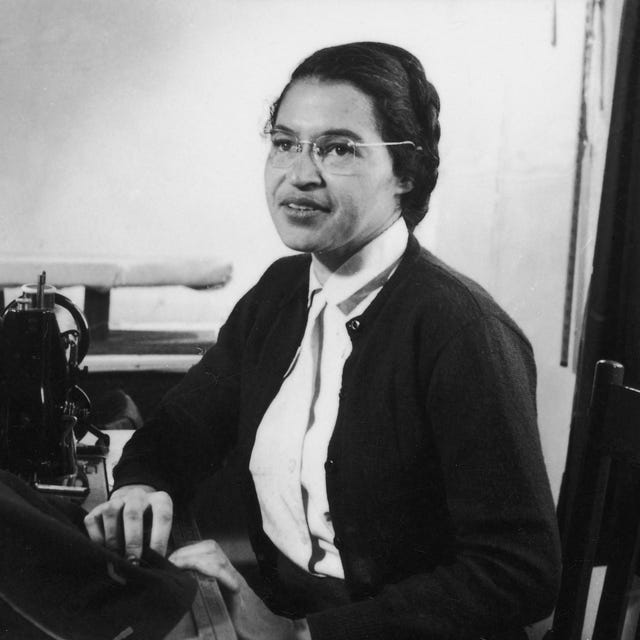
After the bus boycott, Parks continued to participate in the civil rights movement. She attended the March on Washington in 1963 and in 1965 witnessed the signing of the Voting Rights Act . Her later years saw Parks' work recognized with the Presidential Medal of Freedom and the Congressional Gold Medal.
The following timeline covers notable events and achievements in Parks' long and remarkable life:
February 4, 1913: Rosa Louise McCauley born in Tuskegee, Alabama to James and Leona McCauley
1919: A six-year-old Parks begins picking cotton alongside her grandparents. She also starts attending a segregated school in Pine Level, Alabama.
1924: As there is no local school for Black children to attend after the sixth grade, McCauley goes to Miss White’s Montgomery Industrial School for Girls in Montgomery, Alabama.
1929: Parks leaves school in the 11th grade to care for her ill grandmother and mother.
1931: While Parks is working as a housekeeper for a white family, a white neighbor attempts to rape her .
1931: Parks is introduced to Raymond Parks, whom she later described as being the first activist she encountered.
December 18, 1932: Rosa weds Raymond Parks
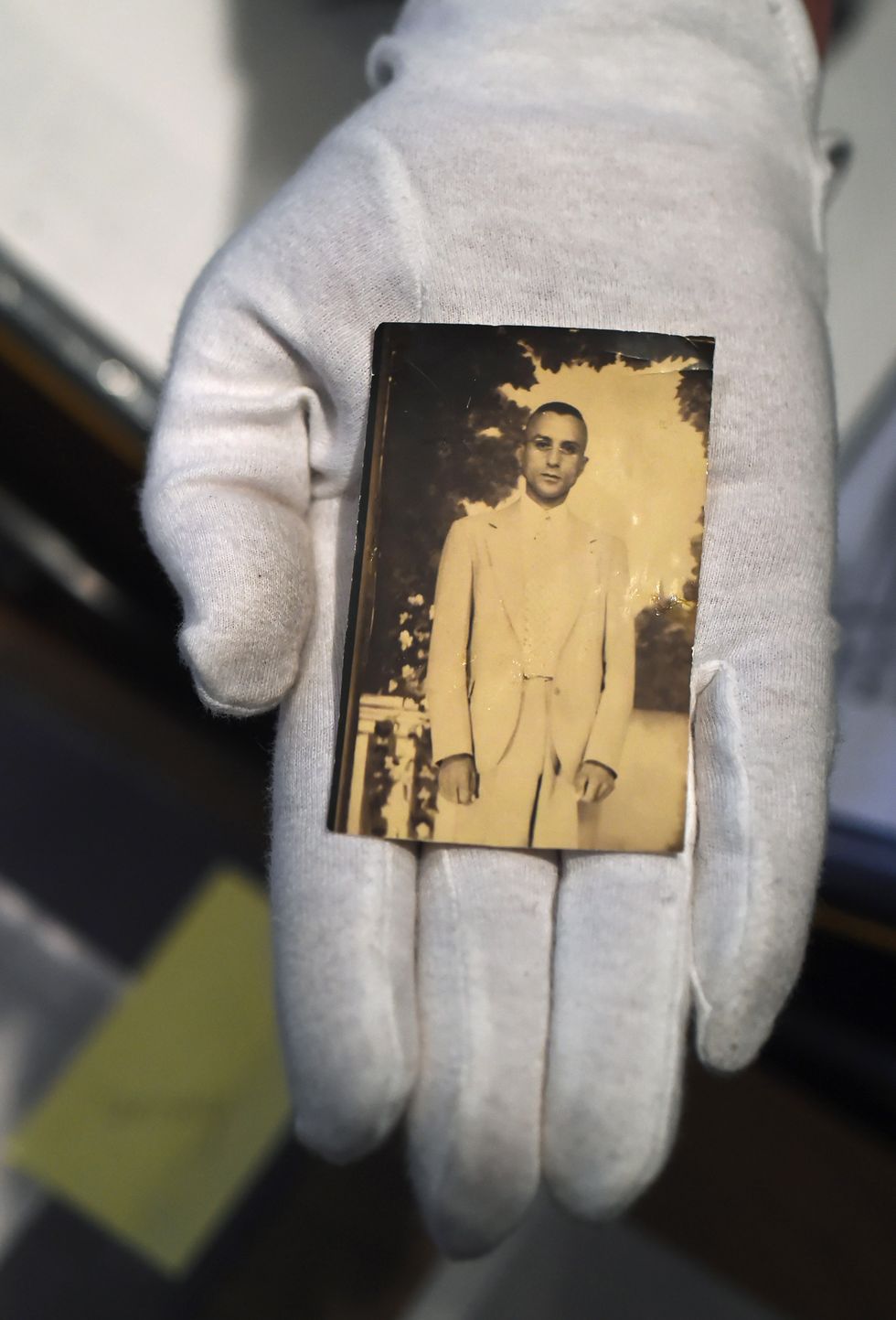
1933: Parks returns to school and obtains her high school diploma, a notable accomplishment at a time when very few Black people in Alabama held this degree.
1941: Parks starts work at Maxwell Air Force Base, which has an integrated cafeteria and trolley system.
December 1943: Parks joins the Montgomery branch of the NAACP
As the only woman at her first meeting, she is named secretary of the group. Parks' work for the NAACP will also include investigating crimes against Black people such as murder, assaults and police brutality.
Parks attempts to register to vote but is told she failed the literacy test required of Black voters.
September 1944: Recy Taylor, a Black woman, is gang-raped by six white men. The Montgomery NAACP dispatches Parks to investigate the case.
Parks helps establish the Committee for Equal Justice for the Rights of Mrs. Recy Taylor to advocate for legal action against Taylor's assailants. The case becomes national news but the rapists are never convicted.
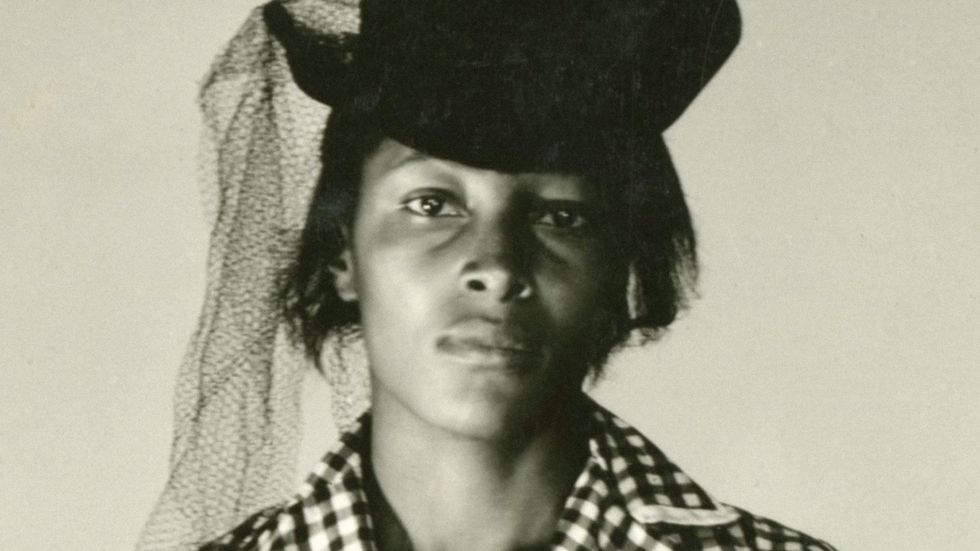
1945: After taking the required literacy test for a third time, Parks becomes a registered voter. Yet before she can cast a ballot, she must pay a retroactive poll tax of $1.50 for every year since she reached the voting age of 21.
1948 : Parks becomes the Alabama state secretary for the NAACP.
1949: Parks steps back as NAACP secretary to take care of her mother.
1952: Parks returns to the Montgomery NAACP and once more becomes a branch secretary.
August 1955: Parks attends a two-week training session at the Highlander Folk School in Tennessee. Alongside other civil rights activists, both Black and white, she discusses how to integrate schools following the Supreme Court's Brown v. Board of Education decision of 1954.
December 1, 1955: In Montgomery, Parks defies a bus driver's order to let a white man take her seat
The driver, who had treated Parks rudely and evicted her from his bus in 1943, contacts the police and she is arrested.
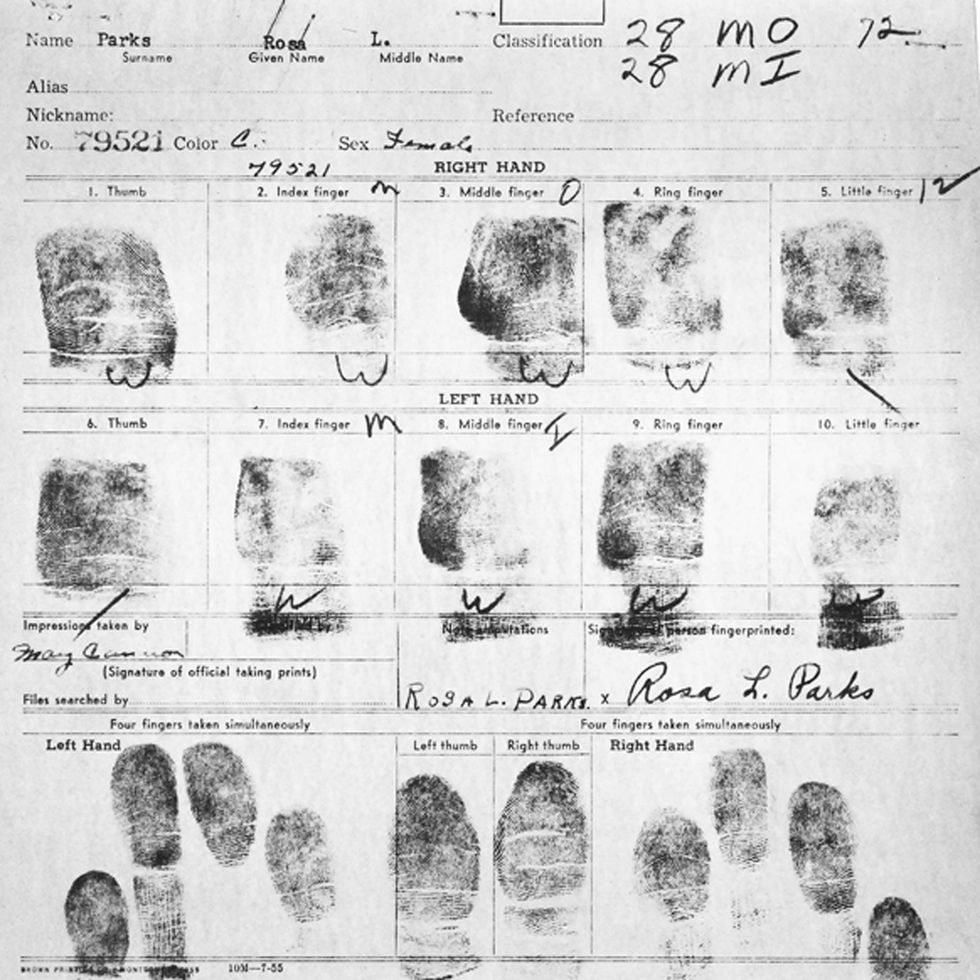
December 5, 1955: Though Parks was not the first Black woman arrested for defying segregation on city buses, news of her case spurs the Black community to begin a boycott of Montgomery buses .
Parks' trial takes place. She is found guilty and fined $10, plus $4 in court costs. Her lawyers file an appeal.
January 7, 1956: Parks is let go from her job as a tailor's assistant at the Montgomery Fair department store.
January 1956: Raymond quits his barbershop job after discussion of his wife and the boycott is forbidden.
February 21, 1956: Along with dozens of other civil rights leaders, including Martin Luther King Jr. , Parks is indicted for violating a Montgomery law outlawing boycotts.
February 22, 1956: Parks is among a group of indicted boycott leaders who present themselves for arrest. She is quickly released. The case against Parks is eventually dismissed.
1956: During the boycott, Parks serves as a dispatcher to coordinate carpools. She also travels across the country to speak about the boycott.
December 21, 1956: Following a Supreme Court ruling that segregated buses are unconstitutional, the 381-day boycott ends. Parks is photographed sitting at the front of a bus for Look magazine.
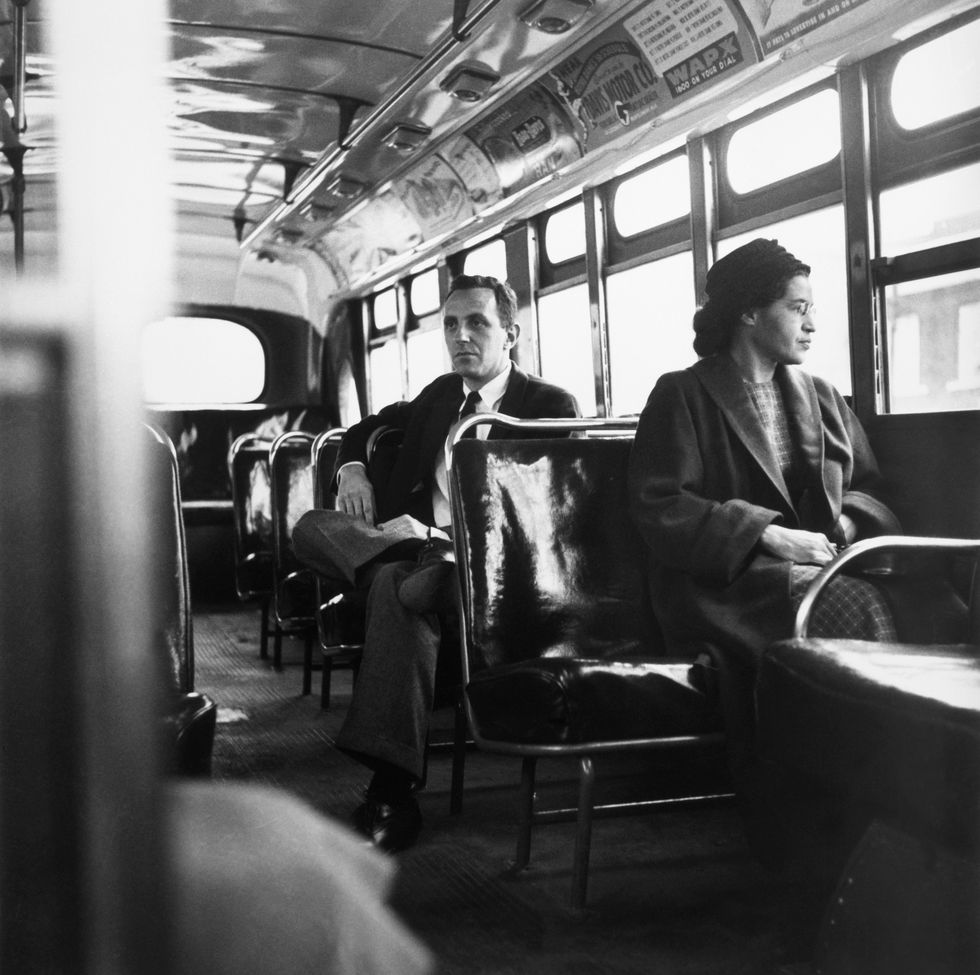
August 1957: Unable to find work in Montgomery and still facing threats for her role in the bus boycott, Parks and her family depart for Detroit
October 1957: Parks becomes a hostess at the Holly Tree Inn, part of the Hampton Institute in Virginia, but leaves after the fall semester in 1958 to rejoin her husband and mother in Detroit.
1959: Parks begins doing piecework for Detroit's Stockton Sewing Company, a job she holds through 1964.
July 1960: A Jet magazine article reveals that Parks and her family have been struggling financially, due in part to her health problems.
August 28, 1963: Parks attends the March on Washington for Jobs and Freedom . No women are invited to speak at the event, but Parks is among those singled out for a "Tribute to Women" in the civil rights movement.
March 1, 1965: Parks takes a job in the Detroit office of newly elected Congressman John Conyers, where her tasks include answering phones and aiding constituents. She stays in this position until her retirement in 1988.
March 25, 1965: Parks joins the march to Montgomery for equal voting rights. Many of the marchers do not recognize her but in the end she is acknowledged and invited to speak at the capitol building.
August 6, 1965: Parks is among those present to witness President Lyndon Johnson's signing of the Voting Rights Act.
July 23, 1967: Parks is in Detroit during five days of rioting. Amid the upheaval, her husband's barbershop is destroyed.
August 30, 1967: A "People's Tribunal" is held regarding the deaths of three young Black men during the Detroit riots. Parks serves on the jury, which finds the police who were at the scene guilty (the officers faced no such repercussions in the legal system).
August 19, 1977: Parks' husband, Raymond, dies.
August 1979: The NAACP presents Parks with its highest accolade, the Spingarn Medal.
January 14, 1980: Parks is given the Martin Luther King Jr. Nonviolent Peace Prize
1987: Parks establishes the Rosa and Raymond Parks Institute for Self Development, intended to help young people better understand the past and prepare for their futures.
1992: Rosa Parks: My Story , an autobiography for younger readers, is published.
August 30, 1994: Parks is robbed and beaten by a mugger inside her home.
October 16, 1995: At the invitation of Nation of Islam leader Louis Farrakhan, Parks attends the Million Man March in Washington, D.C.
1994: Another book by Parks, entitled Quiet Strength , is published.
September 15, 1996: Parks is presented with the Presidential Medal of Freedom by Bill Clinton .
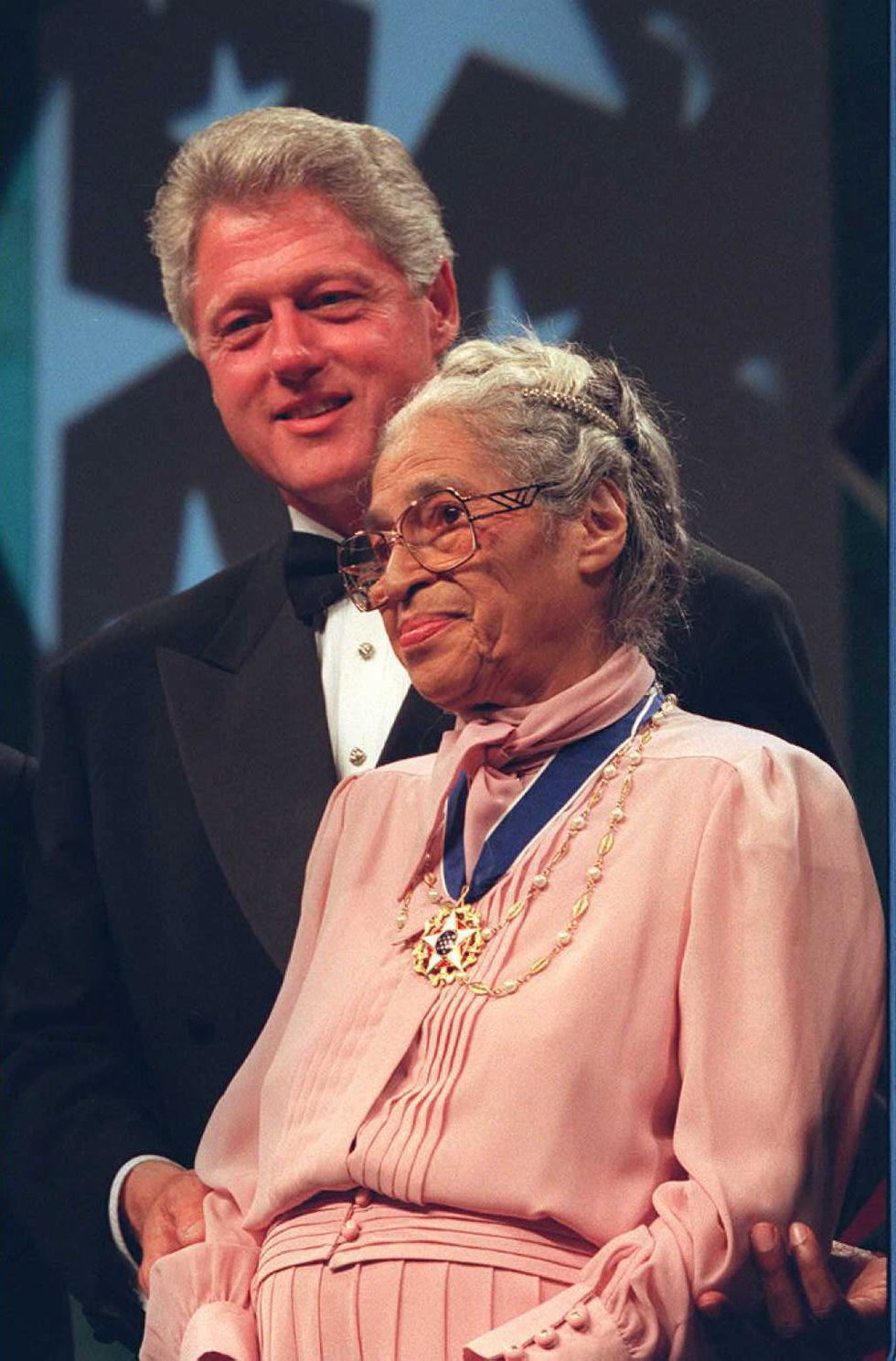
June 15, 1999: Parks receives the Congressional Gold Medal, the highest legislative honor in the United States.
April 14, 2005: Parks and the hip-hop group Outkast reach an out-of-court settlement regarding their 1998 song "Rosa Parks."
October 24, 2005: Parks dies at the age of 92
Her body is brought to lie in honor at the U.S. Capitol Rotunda, the first time for a woman to receive this recognition.
Watch “Rosa Parks: Mother Of A Movement” on History Vault
Black History

Jesse Owens

Alice Coachman

Wilma Rudolph

Tiger Woods

Deb Haaland

10 Famous Langston Hughes Poems

5 Crowning Achievements of Maya Angelou

Ava DuVernay

Octavia Spencer

Inventor Garrett Morgan’s Lifesaving 1916 Rescue

Get to Know 5 History-Making Black Country Singers

- Member Interviews
- Science & Exploration
- Public Service
- Achiever Universe
- Summit Overview
- About The Academy
- Academy Patrons
- Delegate Alumni
- Directors & Our Team
- Golden Plate Awards Council
- Golden Plate Awardees
- Preparation
- Perseverance
- The American Dream
- Recommended Books
- Find My Role Model
All achievers
Pioneer of civil rights.

Download our free multi-touch iBook The Road to Civil Rights — available for your Mac or iOS device on Apple Books
The Road to Civil Rights iBook takes readers on a journey through one of the most significant periods in America’s history. Travel through the timeline and listen to members of the American Academy of Achievement as they discuss the key events that shaped the future of the country.

Listen to this achiever on What It Takes
What It Takes is an audio podcast produced by the American Academy of Achievement featuring intimate, revealing conversations with influential leaders in the diverse fields of endeavor: public service, science and exploration, sports, technology, business, arts and humanities, and justice.
Two policemen came on the bus, and one asked me if the driver had told me to stand. He wanted to know why I didn’t stand, and I told him I didn’t think I should have to stand up. I asked him, why did they push us around? He said, I don’t know, but the law is the law and you are under arrest.
Most historians date the beginning of the modern civil rights movement in the United States to December 1, 1955. That was the day when an unknown seamstress in Montgomery, Alabama refused to give up her bus seat to a white passenger. This brave woman, Rosa Parks, was arrested and fined for violating a city ordinance, but her lonely act of defiance began a movement that ended legal segregation in America, and made her an inspiration to freedom-loving people everywhere.

Rosa Parks was born Rosa Louise McCauley in Tuskegee, Alabama to James McCauley, a carpenter, and Leona McCauley, a teacher. At the age of two she moved to her grandparents’ farm in Pine Level, Alabama with her mother and younger brother, Sylvester. At the age of 11 she enrolled in the Montgomery Industrial School for Girls, a private school founded by liberal-minded women from the northern United States.

The school’s philosophy of self-worth was consistent with Leona McCauley’s advice to “take advantage of the opportunities, no matter how few they were.” Opportunities were few indeed. “Back then,” Mrs. Parks recalled in an interview, “we didn’t have any civil rights. It was just a matter of survival, of existing from one day to the next. I remember going to sleep as a girl hearing the Klan ride at night and hearing a lynching and being afraid the house would burn down.” In the same interview, she cited her lifelong acquaintance with fear as the reason for her relative fearlessness in deciding to appeal her conviction during the bus boycott. “I didn’t have any special fear,” she said. “It was more of a relief to know that I wasn’t alone.” After attending Alabama State Teachers College, the young Rosa settled in Montgomery, with her husband, Raymond Parks. The couple joined the local chapter of the NAACP and worked quietly for many years to improve the lot of African Americans in the segregated South.

“I worked on numerous cases with the NAACP,” Mrs. Parks recalled, “but we did not get the publicity. There were cases of flogging, peonage, murder, and rape. We didn’t seem to have too many successes. It was more a matter of trying to challenge the powers that be, and to let it be known that we did not wish to continue being second-class citizens.”
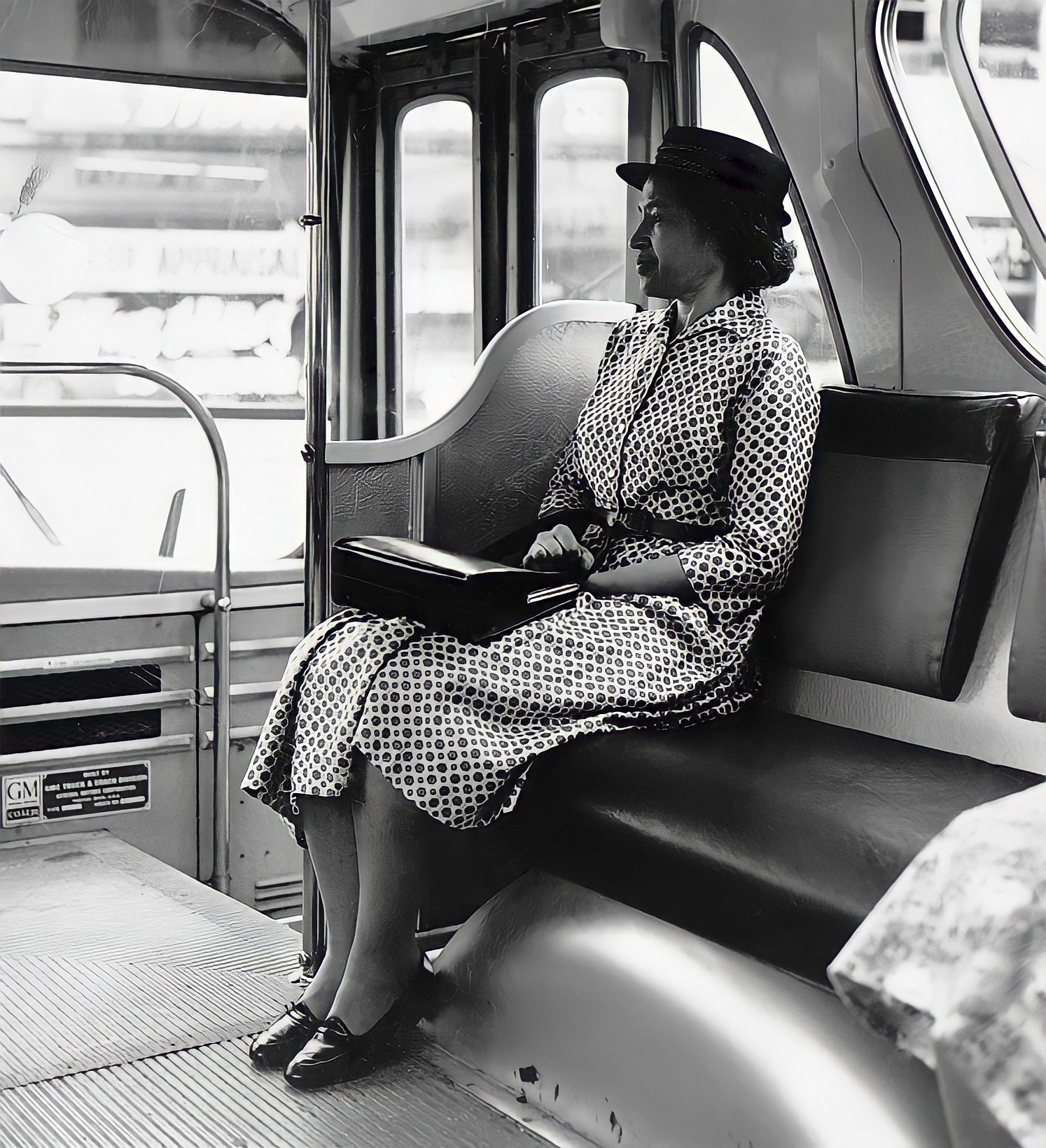
The bus incident led to the formation of the Montgomery Improvement Association, led by the young pastor of the Dexter Avenue Baptist Church, Dr. Martin Luther King, Jr. The association called for a boycott of the city-owned bus company. The boycott lasted 381 days and brought Mrs. Parks, Dr. King, and their cause to the attention of the world. A Supreme Court decision struck down the Montgomery ordinance under which Mrs. Parks had been fined, and outlawed racial segregation on public transportation.

In 1957, Mrs. Parks and her husband moved to Detroit, Michigan, where Mrs. Parks served on the staff of U.S. Representative John Conyers. The Southern Christian Leadership Council established an annual Rosa Parks Freedom Award in her honor.

After the death of her husband in 1977, Mrs. Parks founded the Rosa and Raymond Parks Institute for Self-Development. The Institute sponsors an annual summer program for teenagers called Pathways to Freedom. The young people tour the country in buses, under adult supervision, learning the history of their country and of the civil rights movement. President Clinton presented Rosa Parks with the Presidential Medal of Freedom in 1996. She received a Congressional Gold Medal in 1999.

When asked if she was happy living in retirement, Rosa Parks replied, “I do the very best I can to look upon life with optimism and hope and looking forward to a better day, but I don’t think there is any such thing as complete happiness. It pains me that there is still a lot of Klan activity and racism. I think when you say you’re happy, you have everything that you need and everything that you want, and nothing more to wish for. I haven’t reached that stage yet.”
Mrs. Parks spent her last years living quietly in Detroit, where she died in 2005 at the age of 92. After her death, her casket was placed in the rotunda of the United States Capitol for two days, so the nation could pay its respects to the woman whose courage had changed the lives of so many. She was the first woman and the second African American to lie in honor at the Capitol, a distinction usually reserved for Presidents of the United States.
View and listen to Dr. Martin Luther King, Jr.’s historic “I Have a Dream” speech, delivered on the steps of Lincoln Memorial in Washington, D.C., August 28, 1963.
Member of the American Academy of Achievement, poet and best-selling author, Maya Angelou shares her interpretation of Dr. Martin Luther King’s “I Have a Dream” speech.

Rosa Parks, the “Mother of the Civil Rights Movement” was one of the most important citizens of the 20th century. Mrs. Parks was a seamstress in Montgomery, Alabama when, in December of 1955, she refused to give up her seat on a city bus to a white passenger. The bus driver had her arrested. She was tried and convicted of violating a local ordinance.
Her act sparked a citywide boycott of the bus system by blacks that lasted more than a year. The boycott raised an unknown clergyman named Martin Luther King, Jr., to national prominence and resulted in the U.S. Supreme Court decision outlawing segregation on city buses. Over the next four decades, she helped make her fellow Americans aware of the history of the civil rights struggle. This pioneer in the struggle for racial equality was the recipient of innumerable honors, including the Martin Luther King Jr. Nonviolent Peace Prize and the Presidential Medal of Freedom. Her example remains an inspiration to freedom-loving people everywhere.
In 1955, you refused to give up your seat to a white passenger on a public bus in Montgomery, Alabama. Your act inspired the Montgomery Bus Boycott, the event historians call the beginning of the modern Civil Rights Movement. Could you tell us exactly what happened that day?
Rosa Parks: I was arrested on December 1, 1955 for refusing to stand up on the orders of the bus driver, after the white seats had been occupied in the front. And of course, I was not in the front of the bus as many people have written and spoken that I was — that I got on the bus and took the front seat, but I did not. I took a seat that was just back of where the white people were sitting, in fact, the last seat. A man was next to the window, and I took an aisle seat and there were two women across. We went on undisturbed until about the second or third stop when some white people boarded the bus and left one man standing. And when the driver noticed him standing, he told us to stand up and let him have those seats. He referred to them as front seats. And when the other three people — after some hesitancy — stood up, he wanted to know if I was going to stand up, and I told him I was not. And he told me he would have me arrested. And I told him he may do that. And of course, he did. Two policemen came on the bus and one asked me if the driver had told me to stand and I said, “Yes.” And he wanted to know why I didn’t stand, and I told him I didn’t think I should have to stand up. And then I asked him, why did they push us around? And he said, and I quote him, “I don’t know, but the law is the law and you are under arrest.” And with that, I got off the bus, under arrest.
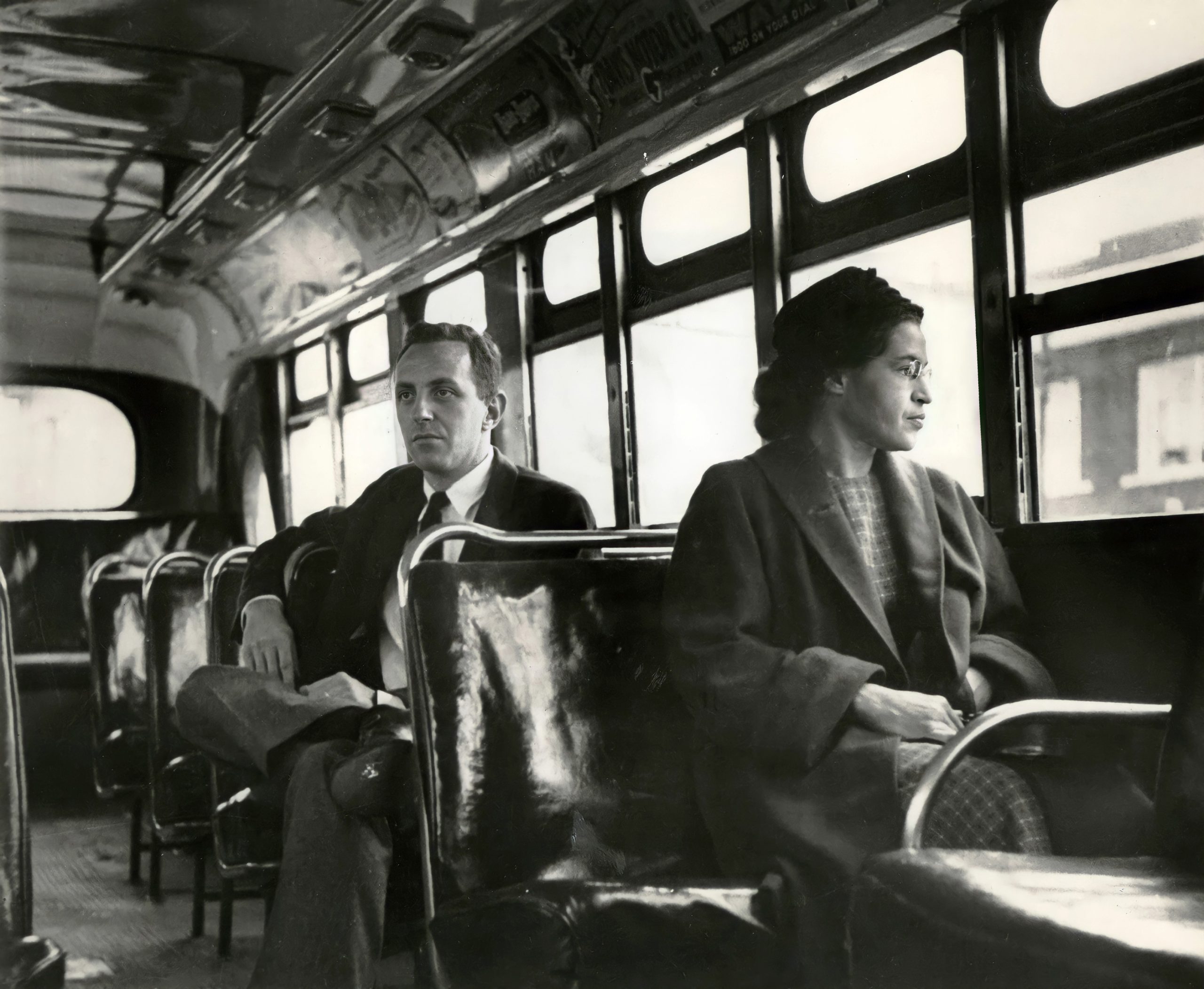
Did they take you down to the police station?
Rosa Parks: Yes. A policeman wanted the driver to swear out a warrant, if he was willing, and he told him that he would sign a warrant when he finished his trip and delivered his passengers, and he would come straight down to the City Hall to sign a warrant against me.

Did he do that?
Rosa Parks: Yes, he did.

Did the public response begin immediately?
Rosa Parks: Actually, it began as soon as it was announced.
It was put in the paper that I had been arrested. Mr. E.D. Nixon was the legal redress chairman of the Montgomery branch of the NAACP, and he made a number of calls during the night, called a number of ministers. I was arrested on a Thursday evening, and on Friday evening is when they had the meeting at the Dexter Avenue Baptist Church, where Dr. Martin Luther King was the pastor. A number of citizens came, and I told them the story and from then on, it became news about my being arrested. My trial was December 5, when they found me guilty. The lawyers Fred Gray and Charles Langford, who represented me, filed an appeal and, of course, I didn’t pay any fine. We set a meeting at the Holt Street Baptist Church on the evening of December 5th, because December 5th was the day the people stayed off in large numbers and did not ride the bus. In fact, most of the buses, I think all of them were just about empty with the exception of maybe very, very few people. When they found out that one day’s protest had kept people off the bus, it came to a vote and unanimously, it was decided that they would not ride the buses anymore until changes for the better were made.

When you refused to stand up, did you have a sense of anger at having to do it?
Rosa Parks: I don’t remember feeling that anger, but I did feel determined to take this as an opportunity to let it be known that I did not want to be treated in that manner and that people have endured it far too long. However, I did not have at the moment of my arrest any idea of how the people would react. And since they reacted favorably, I was willing to go with that. We formed what was known as the Montgomery Improvement Association, on the afternoon of December 5th. Dr. Martin Luther King became very prominent in this movement, so he was chosen as a spokesman and the president of the Montgomery Improvement Association.

What are your thoughts when you look back on that time in your life. Any regrets?
As I look back on those days, it’s just like a dream. The only thing that bothered me was that we waited so long to make this protest and to let it be known wherever we go that all of us should be free and equal and have all opportunities that others should have.
What personal characteristics do you think are most important to accomplish something?
Rosa Parks: I think it’s important to believe in yourself and when you feel like you have the right idea, to stay with it. And of course, it all depends upon the cooperation of the people around. People were very cooperative in getting off the buses. And from that, of course, we went on to other things. I, along with Mrs. Field, who was here with me, organized the Rosa and Raymond Parks Institute for Self-Development. Raymond, my husband—he is now deceased—was another person who inspired me, because he believed in freedom and equality himself.

You were married during the bus incident.
Rosa Parks: Yes, I was.
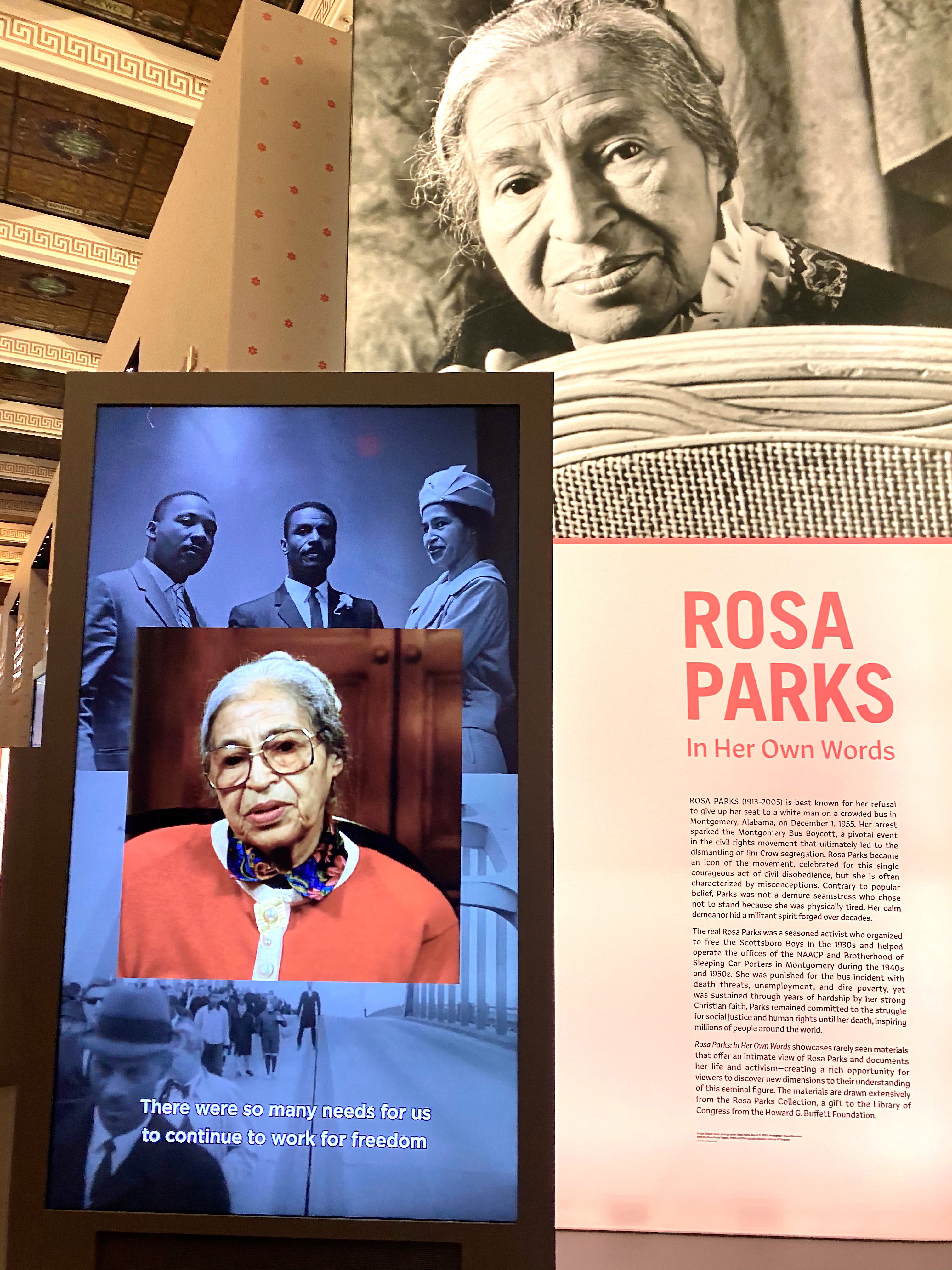
How old were you?
Rosa Parks: When I was arrested, I was 42 years old. There were so many needs for us to continue to work for freedom, because I didn’t think that we should have to be treated in the way we were, just for the sake of white supremacy, because it was designed to make them feel superior, and us feel inferior. That was the whole plan of racially enforced segregation.
What was it like in Montgomery when you were growing up?
Rosa Parks: Back in Montgomery during my growing up there, it was completely legally enforced racial segregation, and of course, I struggled against it for a long time. I felt that it was not right to be deprived of freedom when we were living in the Home of the Brave and Land of the Free. Of course, when I refused to stand up, on the orders of the bus driver, for a white passenger to take the seat, and I was not sitting in the front of the bus, as so many people have said, and neither was my feet hurting, as many people have said. But I made up my mind that I would not give in any longer to legally-imposed racial segregation and of course my arrest brought about the protests for more than a year. And in doing so, Dr. Martin Luther King became prominent because he was the leader of our protests along with many other people. And I’m very glad that this experience I had then brought about a movement that triggered across the United States and in other places.
- 26 photos
- African American Heroes
How her refusal to give up her seat sparked a movement
Rosa Parks stood up for African Americans—by sitting down.
Although Abraham Lincoln ’s 1863 Emancipation Proclamation granted slaves their freedom, for many years Black people were discriminated against in much of the United States. In southern states, for instance, most Black children were forced to attend separate schools from white kids in classrooms that were often rundown, with outdated books. African Americans also couldn’t eat at the same restaurants as white people and had to sit in the back seats of public buses. Segregation—the separation of races—was enforced by local laws.
Rosa Parks was born on February 4, 1913. On December 1, 1955, she boarded a city bus in Montgomery, Alabama and sat in the middle, where Black passengers in that city were allowed to sit unless a white person wanted the seat. As the bus filled with new riders, the driver told Parks to give up her seat to a white passenger. She refused. The driver called police, and Parks was arrested.
Her arrest sparked a major protest. For more than a year, most Black people in Montgomery stood together and refused to take city buses. (One of the leaders of the boycott was a young local pastor named Martin Luther King, Jr. ) Public vehicles stood idle, and the city lost money. Still, the Montgomery Bus Boycott didn’t end until a 1956 Supreme Court decision ended racial segregation on public transportation throughout the United States.
Parks died on October 24, 2005. But throughout her life, her refusal to give up her seat inspired many others to fight for African-American rights and helped advance the civil rights movement of the 1950s and '60s.
Read this next
African american pioneers of science, black history month, 1963 march on washington.
- Terms of Use
- Privacy Policy
- Your California Privacy Rights
- Children's Online Privacy Policy
- Interest-Based Ads
- About Nielsen Measurement
- Do Not Sell My Info
- National Geographic
- National Geographic Education
- Shop Nat Geo
- Customer Service
- Manage Your Subscription
Copyright © 1996-2015 National Geographic Society Copyright © 2015-2024 National Geographic Partners, LLC. All rights reserved

- DIGITAL MAGAZINE
MOST POPULAR
The life of Rosa Parks
Learn about this remarkable civil rights activist….
Discover how this remarkable woman helped change the lives of millions of African Americans and the history of her country in our Rosa Parks facts…
All people should be treated equally, right? Regardless of where you come from, what religion you follow, where you work, what language you speak or whether you’re a boy or a girl. Well, sadly, this isn’t always the case, and many groups of people around the world still suffer as a result of prejudices and discrimination .
Thankfully, there are some amazing people who have done incredible things to fight for equality. One such person was a civil rights activist called Rosa Parks .
Rosa Parks facts
Who was rosa parks.
Full name : Rosa Louise McCauley Parks Born : 4 February 1913 Hometown : Tuskegee, Alabama, USA Occupation : Civil rights activist Died : 24 October 2005 Best known for : The Montgomery Bus Boycott
Rosa was born in the town of Tuskegee in Alabama , a state in southern USA. Her mother was a teacher and her father a carpenter, and she had a little brother called Sylvester. After her parents separated when she was just a little girl, Rosa and Sylvester moved with their mother to Alabama’s capital city, Montgomery .

Rosa loved to learn and studied hard at high school. But, sadly, she had to leave school at 16 to care for her dying grandmother and, shortly after, her very sick mother. When she was 19 years old, Rosa married a barber called Raymond Parks , who encouraged her to return to high school to earn her diploma (an education certificate). And that’s just what she did, before beginning work as a seamstress in Montgomery.
Racial segregation
Life for African Americans like Rosa was hard. At the time, the Southern United States operated under the ‘ Jim Crow laws ’ – a set of laws introduced in the late 19th century that claimed to give African Americans “ separate but equal ” status and treatment. But, in truth, there was no ‘equality’ whatsoever.
Created by white authorities who thought black people’s lives didn’t matter as much as theirs, these laws enforced racial segregation and allowed for discrimination against African Americans – referred to at that time as “colored” people.
The Jim Crow laws were introduced in different ways from state to state, but there was one common goal – to make sure black citizens and white citizens led very separate lives .
Among other things, they had separate schools, churches, libraries, restaurants, toilets, drinking fountains and waiting rooms. In some areas, there were laws banning black people from sports events and even forbidding them to work in the same office as a white person.
African Americans had far fewer rights, too. Racist laws known as ‘ Black Codes ’ restricted them to low-paying jobs and made it incredibly difficult for them to vote. These laws also meant black people could be arrested for small things.
What did Rosa Parks do?

In the face of such racism, Rosa decided to make a stand for what was right. Together with her husband Raymond, she joined the National Association for the Advancement of Coloured People (NAACP) , working towards putting an end to discrimination and segregation.
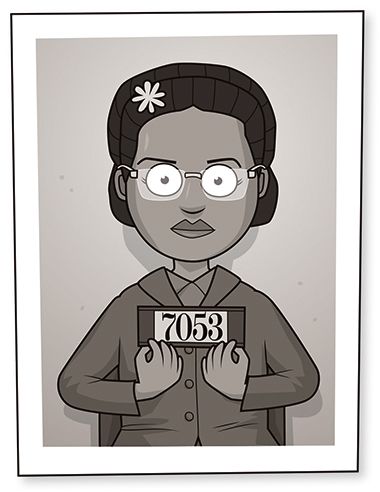
The bus quickly filled up and when a white man boarded, the driver told the African American passengers to give up their seats for him. Whilst the other black passengers obeyed, Rosa did not. The result? Rosa was arrested by the police and fined for breaking segregation laws! But Rosa refused to pay, and argued that it was the law that was wrong , not her behaviour.
The Montgomery Bus Boycott
On news of Rosa’s arrest, the black citizens of Montgomery came together and agreed to boycott the city’s buses in protest. This meant that from 5 December 1955 (the date of Rosa’s trial), African Americans refused to travel on buses. The boycott was managed by an organisation called the Montgomery Improvement Association , for which Dr Martin Luther King Jr was elected as leader.
The protest proved super effective, with more black people participating than had been expected. And since African Americans made up around 70% of bus users, the city’s transport services made far less money and began to struggle. But it wasn’t an easy protest for the black citizens. Many of them didn’t own cars, and so they had to carpool together or walk long distances to get where they needed to go. What’s more, the boycott was received with anger by members of the white population, who responded with aggressive and dangerous acts of violence.
Nevertheless, the protesters stuck together and fought for their cause – and on 13 November 1956 their efforts were finally rewarded. After 381 days of boycotting the buses, the Supreme Court ruled that Alabama’s racial segregation laws were ‘unconstitutional’ – meaning they weren’t valid and should not be recognised. In light of such a wonderful victory, Rosa became known as “ the mother of the civil rights movement ”.
Rosa Parks’ legacy
Sadly, despite the victory, life wasn’t easy for Rosa and her fellow activists after the boycott. Faced with continued violence and threats by angry white groups, Rosa and Raymond moved to Detroit (a city in the northern US state of Michigan), to live with Rosa’s brother.
There she continued to promote civil rights and help those suffering from discrimination and injustice. She continued to support the NAACP and many civil rights events, and in 1987 she co-founded the Rosa and Raymond Parks Institute for Self Development to provide career training for young people in Detroit.

Rosa received numerous awards for her strength, courage and her incredible work for civil rights – including the Presidential Medal of Freedom in 1996 and the Congressional Gold Medal in 1999 .
When did Rosa Parks die?
Rosa died of natural causes on 24 October 2005 at the age of 92. But she continues to be recognised all over the world as a symbol of freedom and equality . Today, commemorative statues stand (or ‘sit’ we should say!) in her honour, to remind us of her remarkable achievements that should never be forgotten.
What do you think of our Rosa Parks facts? Leave a comment below and let us know!
Leave a comment.
Your comment will be checked and approved shortly.
WELL DONE, YOUR COMMENT HAS BEEN ADDED!
Lets take action!
Very good facts
Wow! Rosa is amazing and I think everybody should look up to her!
I think she was a very brave woman! And is a guide for all people;)
I am amazing and so is Rosa parks
Wow, this was so interesting to hear I’m very proud of Rosa and we all are!!!
Really useful! Thanks!
[…] Rosa Parks (1913 – 2005) […]
thank you rosa parks you were so inspirational and the you natgeokids for being educational and helping realising life isn't just shortcuts there are also some challenges in life to all the people reading this make sure you don't do what those white police men did unluckily there they're are still some people like them so please make this world a better place [sorry its long]
YOU ARE BRAVE
thank you national geographic! you have helped me do my term project very well.
You helped me so much on my book report
100% for you
i think rosa parks was fer and true to every body and wanted to change the world so wites will treat blacks better so it can be fer and make every body treated the same way and she tryed to prove that it dose not mater what you look like.
This was a good article and I enjoyed it very much.It teaches people to keep their own way.I have 2 kids at home
I think it is amazing I learnt so much from it I wrote a story about Rosa Parks my teacher was amazed you should have infinite money.
wow the story of rosa parks is truely a tale of one woman taking on the government to achieve equality for african americans
very useful for teaching me how to ride a bus
I am now full of facts.GO ROSA PARKS!
[…] Check out more information about Rosa Parks here: Rosa Parks information […]
I think that Rosa parks was a very inspirational woman and that she stood up for her own beliefs as everyone should do. She knew her actions would have consequences but she didn't care, she just did what she believed in and what was right.
Rosa Parks is cooool.
She's so cool
Thanks Rosa Parks
Really inspired me!!!
CUSTOMIZE YOUR AVATAR
More like general history.
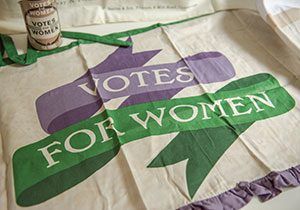
Facts about the suffragettes

Mini Histories Comic – Max Visits the Victorians!
Satellite images hint at lost mayan city.

10 facts about the Tudors!

Sign up to our newsletter
Get uplifting news, exclusive offers, inspiring stories and activities to help you and your family explore and learn delivered straight to your inbox.
You will receive our UK newsletter. Change region
WHERE DO YOU LIVE?
COUNTRY * Australia Ireland New Zealand United Kingdom Other
By entering your email address you agree to our Terms of Use and Privacy Policy and will receive emails from us about news, offers, activities and partner offers.
You're all signed up! Back to subscription site
Type whatever you want to search
More Results

You’re leaving natgeokids.com to visit another website!
Ask a parent or guardian to check it out first and remember to stay safe online.

You're leaving our kids' pages to visit a page for grown-ups!
Be sure to check if your parent or guardian is okay with this first.
- Grades 6-12
- School Leaders
50 Fun Earth Day Crafts and Activities 🌎!
21 Rosa Parks Facts Everyone Should Know
What a legacy!

As one of the most prominent figures in the American Civil Rights Movement, Rosa Parks’ unwavering determination and pivotal role in challenging racial segregation has solidified her place in history. Her courageous act of defiance on a Montgomery bus in 1955 continues to inspire and educate people worldwide about the importance of equality and social justice. Let’s reflect on some key Rosa Parks facts that highlight her remarkable life and contributions.
Important Rosa Parks Facts
Rosa parks was born in 1913..
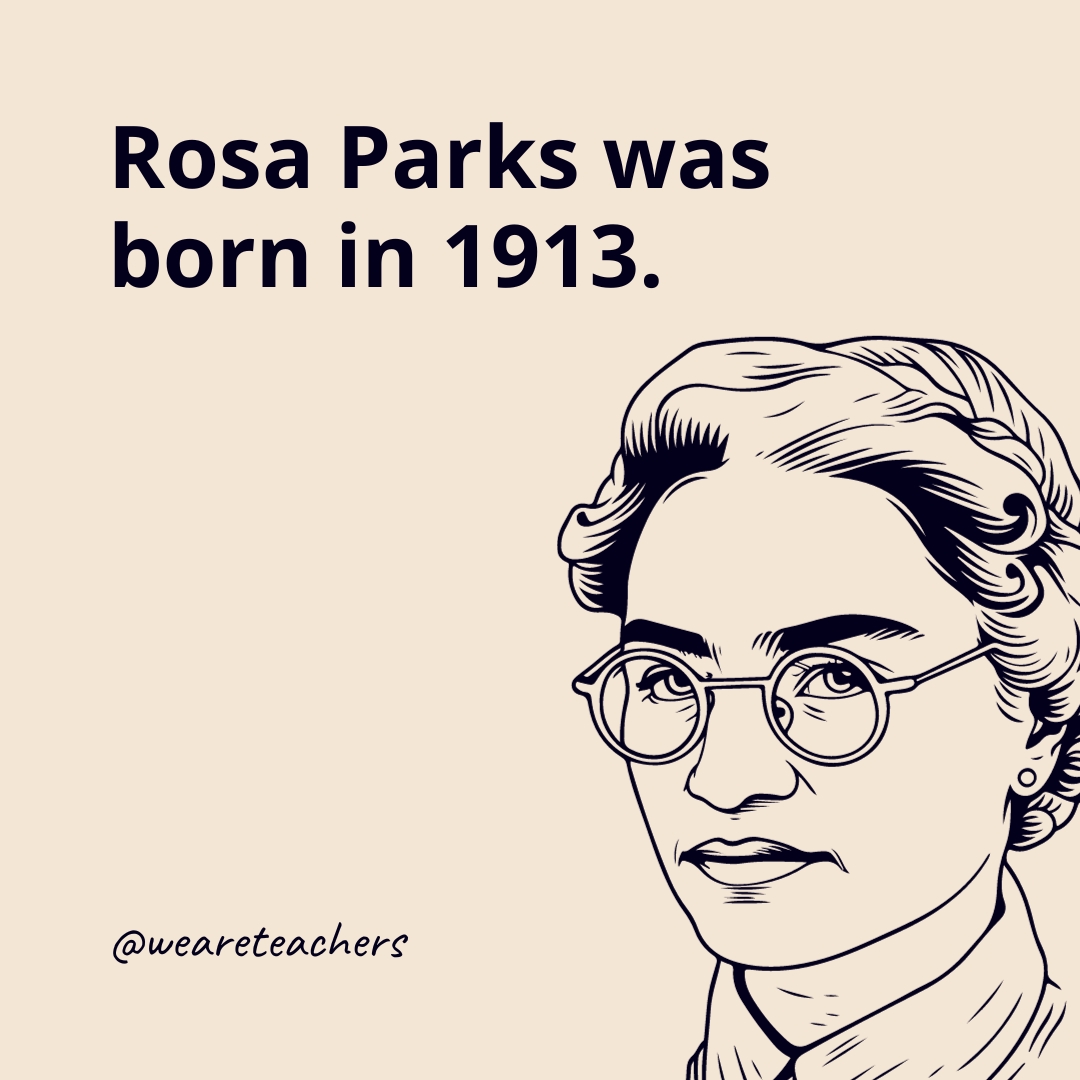
Parks was born in Tuskegee, Alabama.
Source: Library of Congress

Rosa Parks’ grandparents were former slaves.
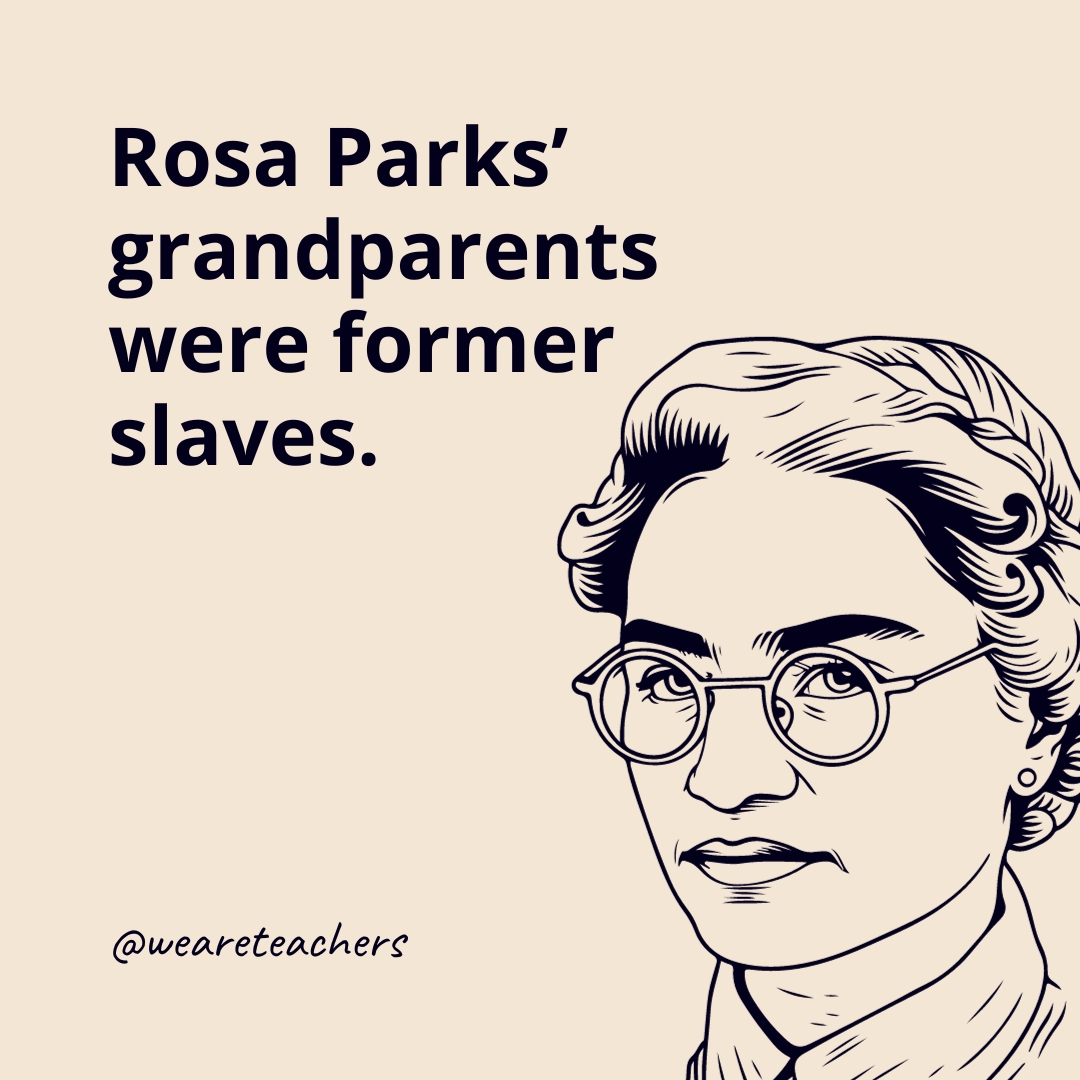
She came from a family of strong advocates for racial equality. She even witnessed her father standing outside with a shotgun as the Ku Klux Klan marched by.
Source: The National Constitution Center
Rosa Parks attended the Montgomery Industrial School for Girls.
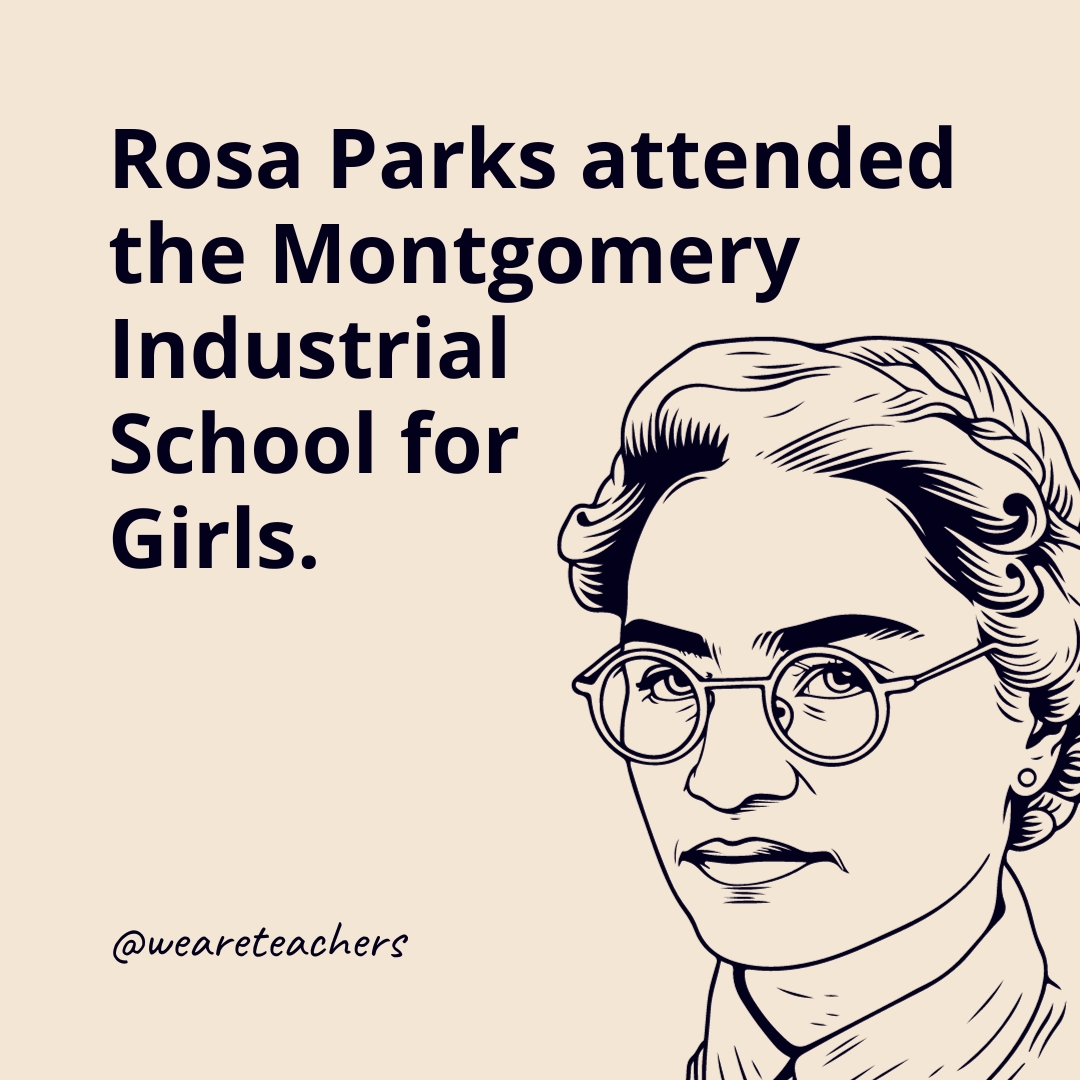
Her family moved to Montgomery, Alabama, in 1914.
Rosa Parks married Raymond A. Parks in 1932.
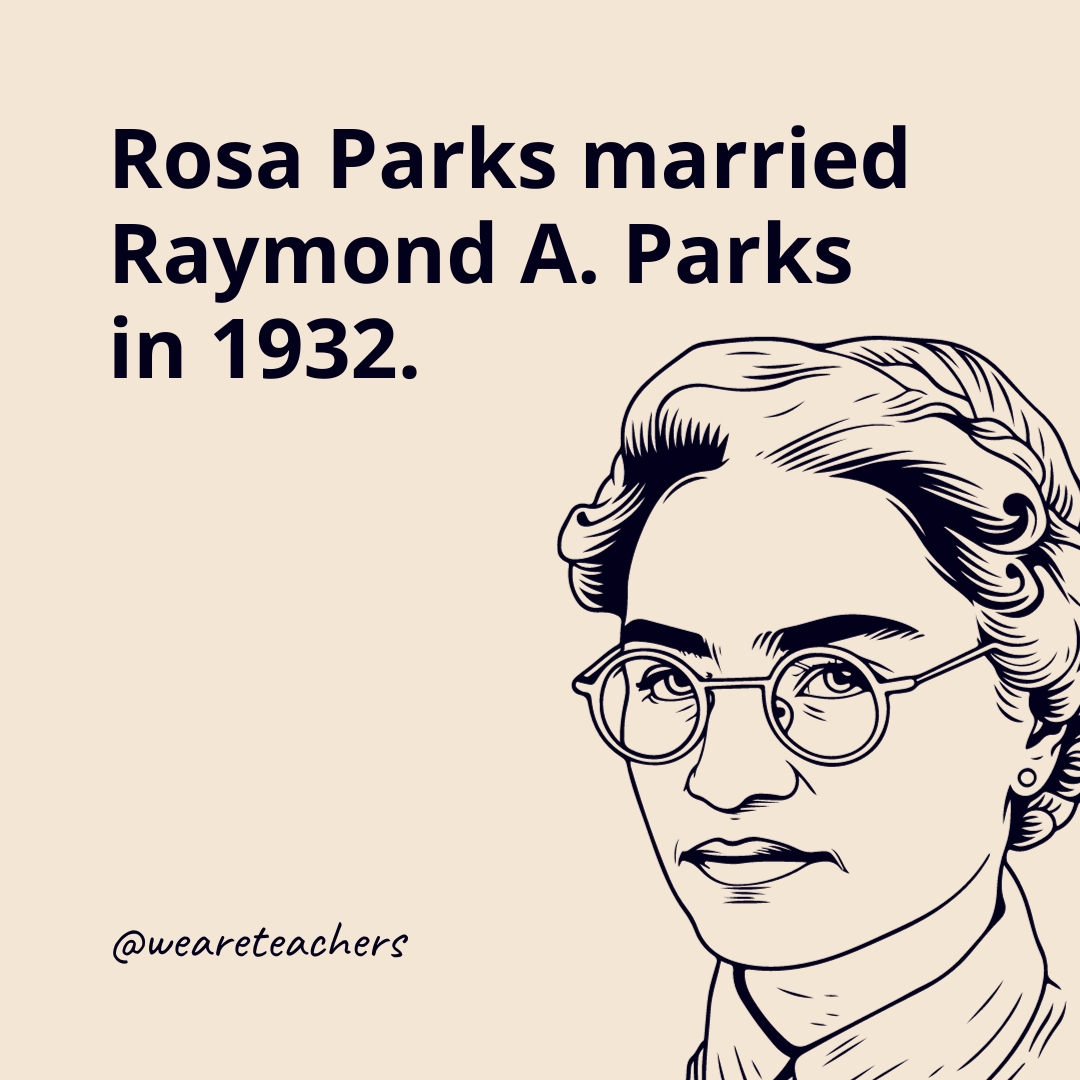
They remained married until his death in 1977.
Rosa Parks graduated from high school.
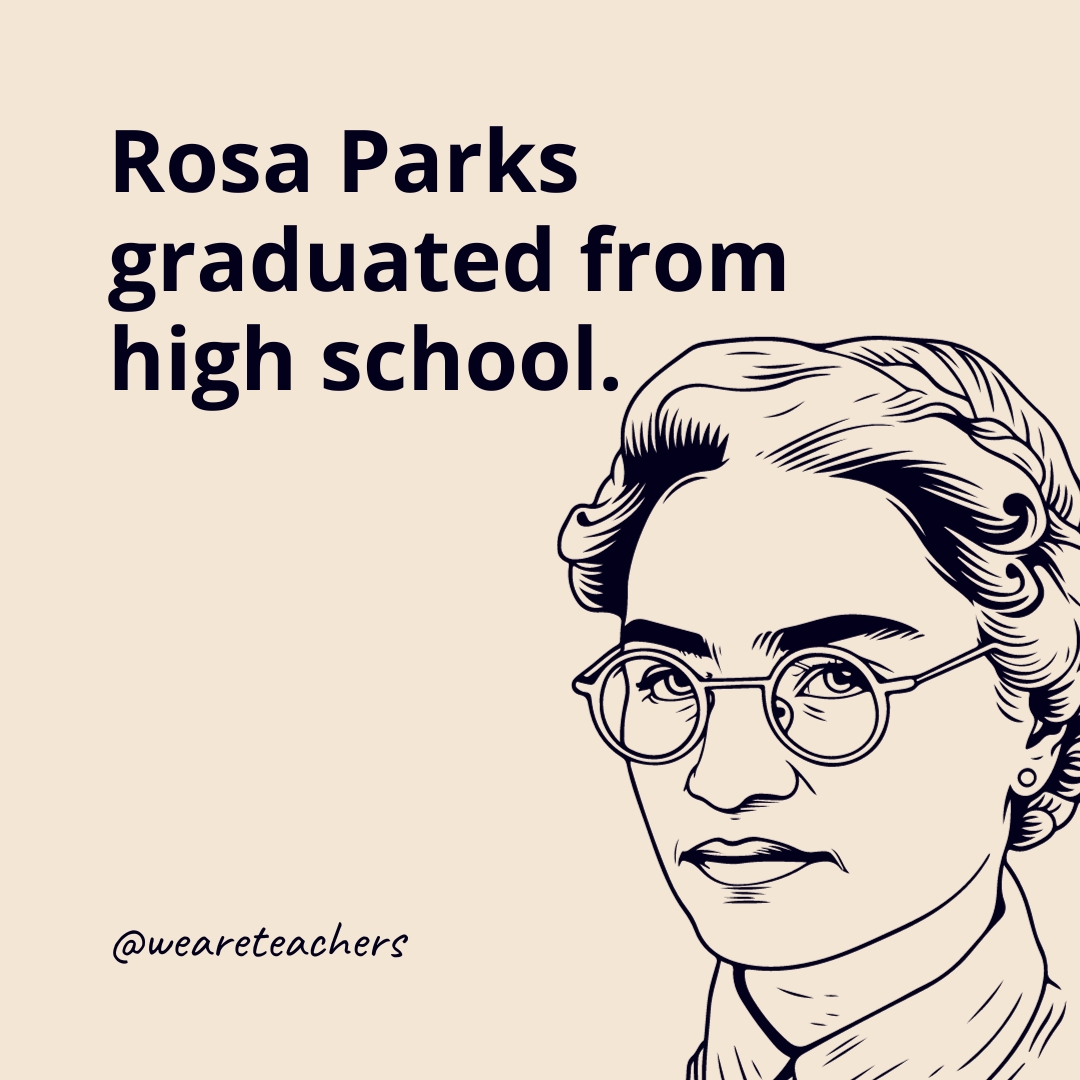
Rosa Parks earned her diploma in 1933 when less than 7% of African Americans graduated from high school. She had dropped out to care for her dying grandmother, but after getting married, her husband encouraged her to return and finish school.
Rosa Parks was the secretary of the NAACP in Montgomery, Alabama.
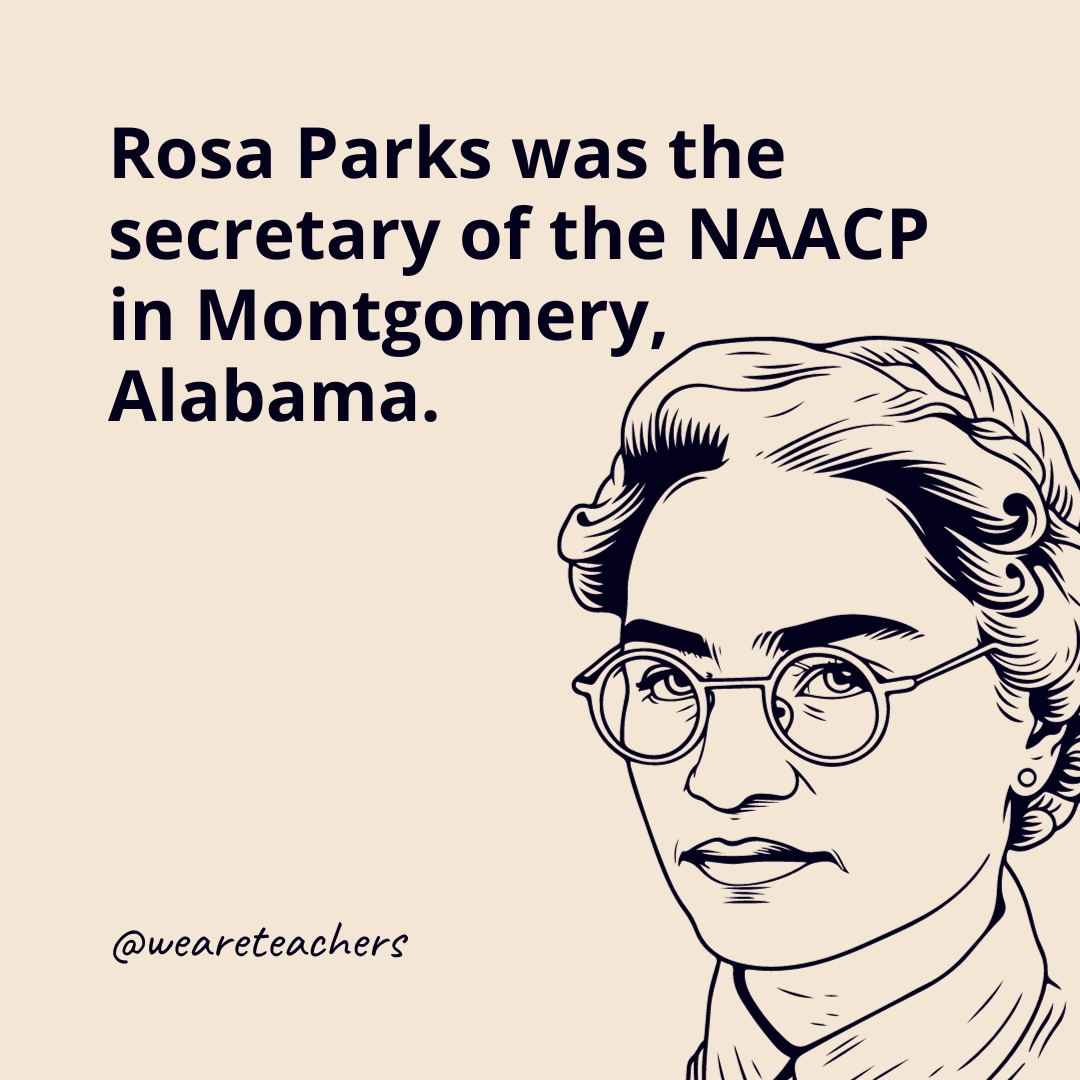
This required Parks to travel throughout Alabama, interviewing victims of discrimination and those who had witnessed lynchings. The NAACP selected her for the role in 1943.
Rosa Parks became an advisor for the NAACP Youth Council.
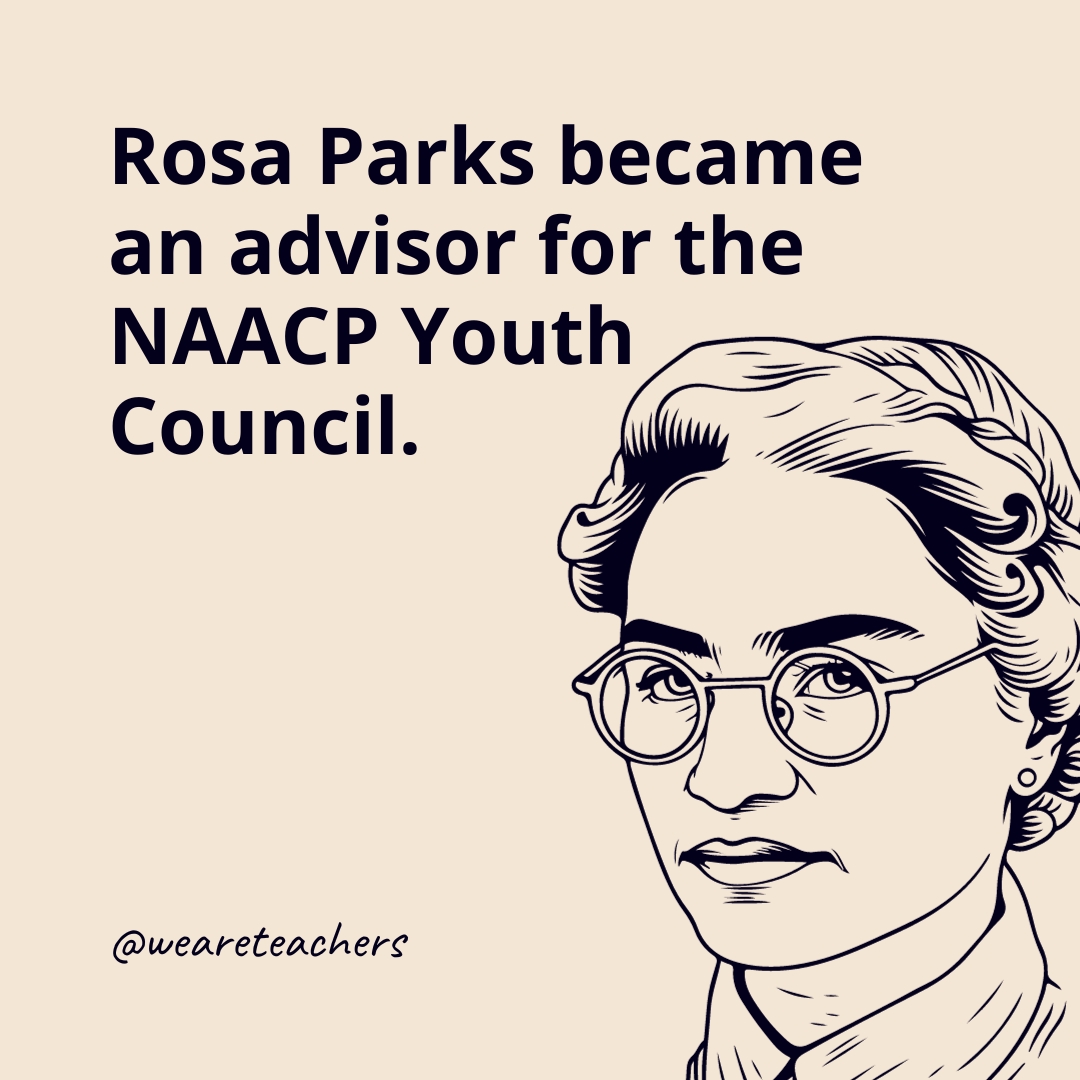
In 1949, Parks encouraged youth members to check out books from the whites-only libraries to challenge the Jim Crow system.
Source: Stanford University
The police arrested Rosa Parks for refusing to give up her bus seat to a white passenger.
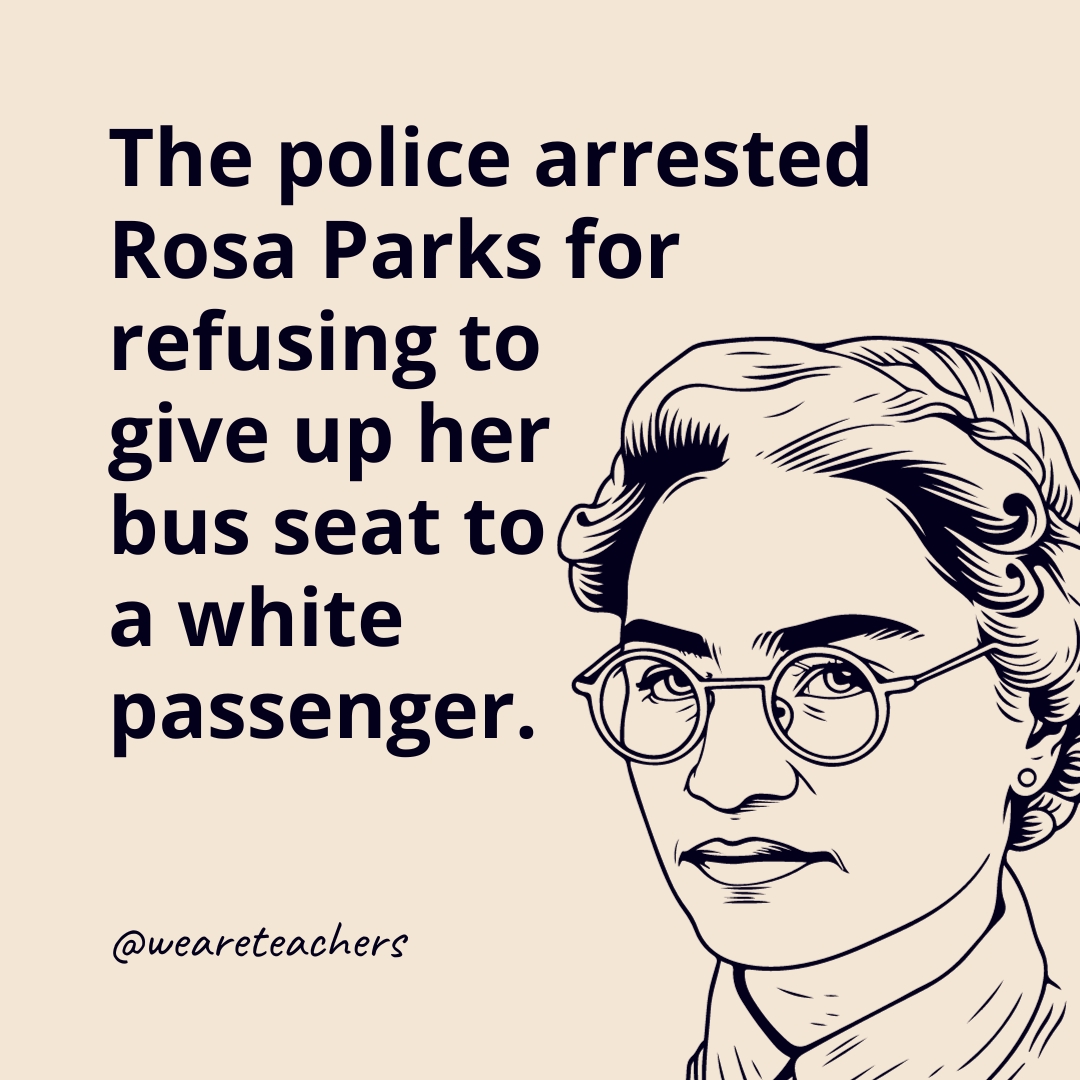
It happened on December 1, 1955. She became the second woman to be arrested for doing so after Claudette Colvin .
Rosa Parks had a history with the bus driver who had her arrested.
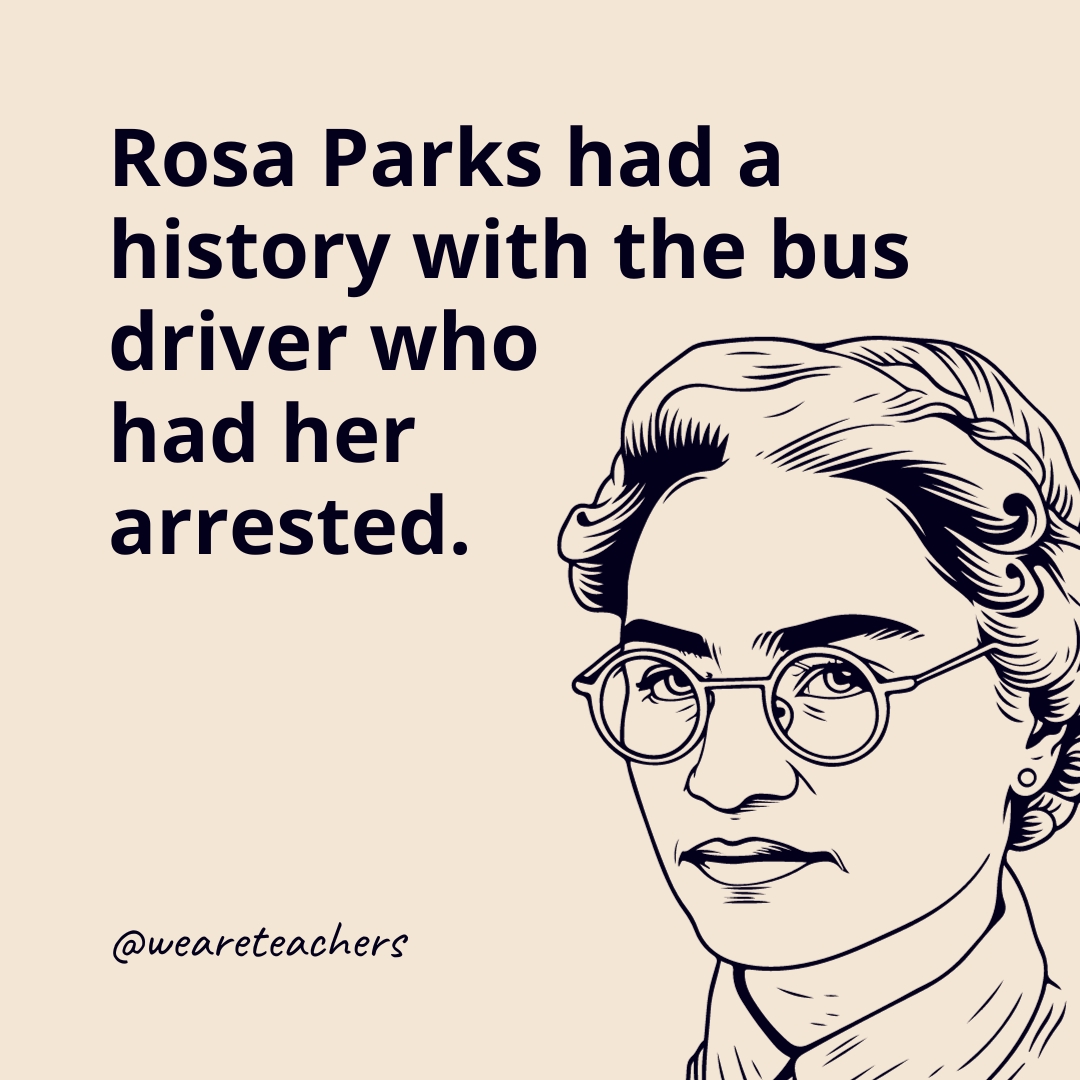
Parks had avoided bus driver James Blake since 1943 when he’d driven off without letting her pay her fare. She had been actively avoiding him but didn’t notice him that day. “If I had been paying attention,” she said , “I wouldn’t even have gotten on that bus.”
Source: The History Channel
Rosa Parks helped organize a boycott of the Montgomery bus system.
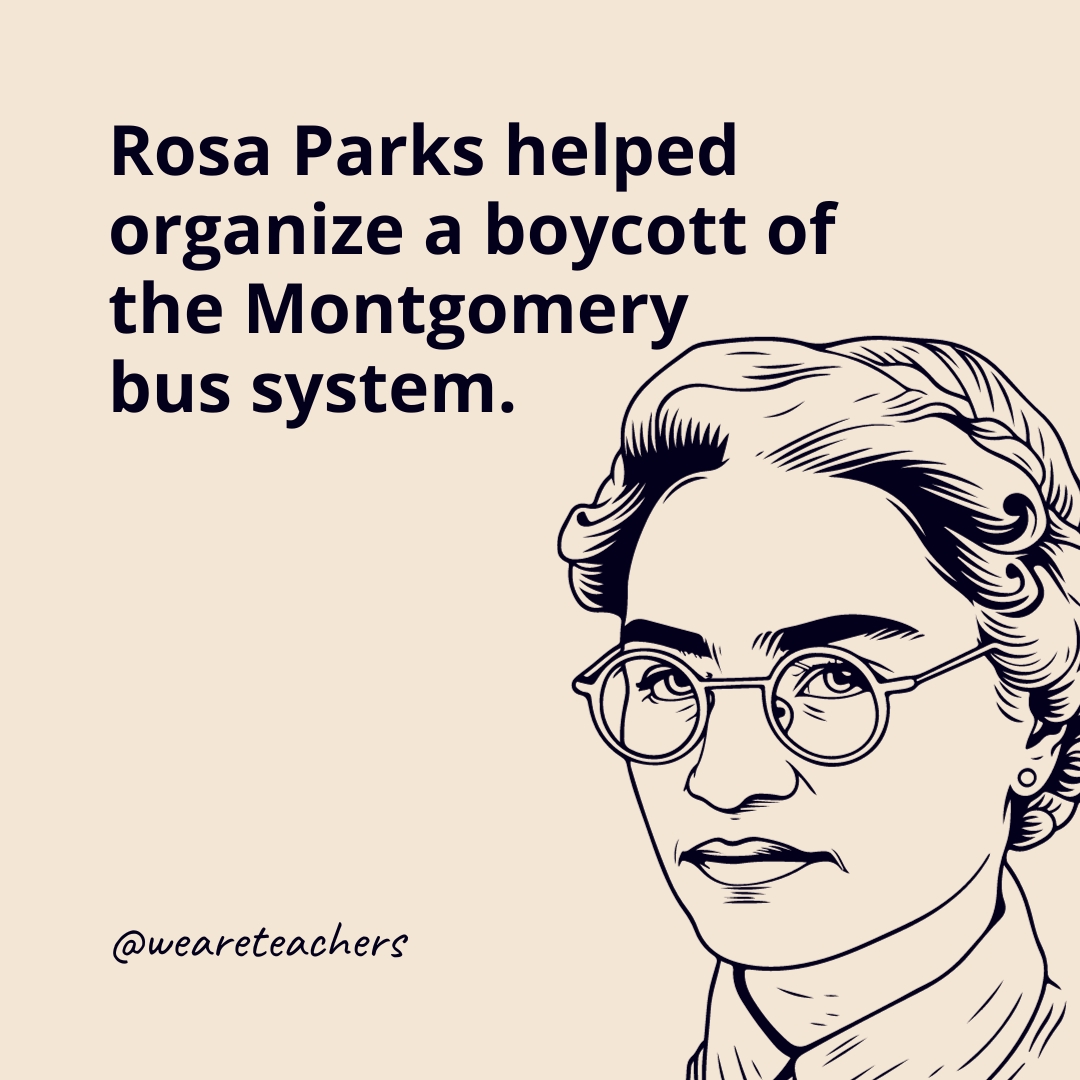
On the day of Parks’ trial, people protested by skipping the bus. Instead, they walked and found other ways to get to work. This inspired the Montgomery Bus Boycott, which lasted for 381 days. In the end, the Supreme Court declared segregation on public transit unconstitutional.
Source: U.S. National Archives
The police arrested Rosa Parks a second time.
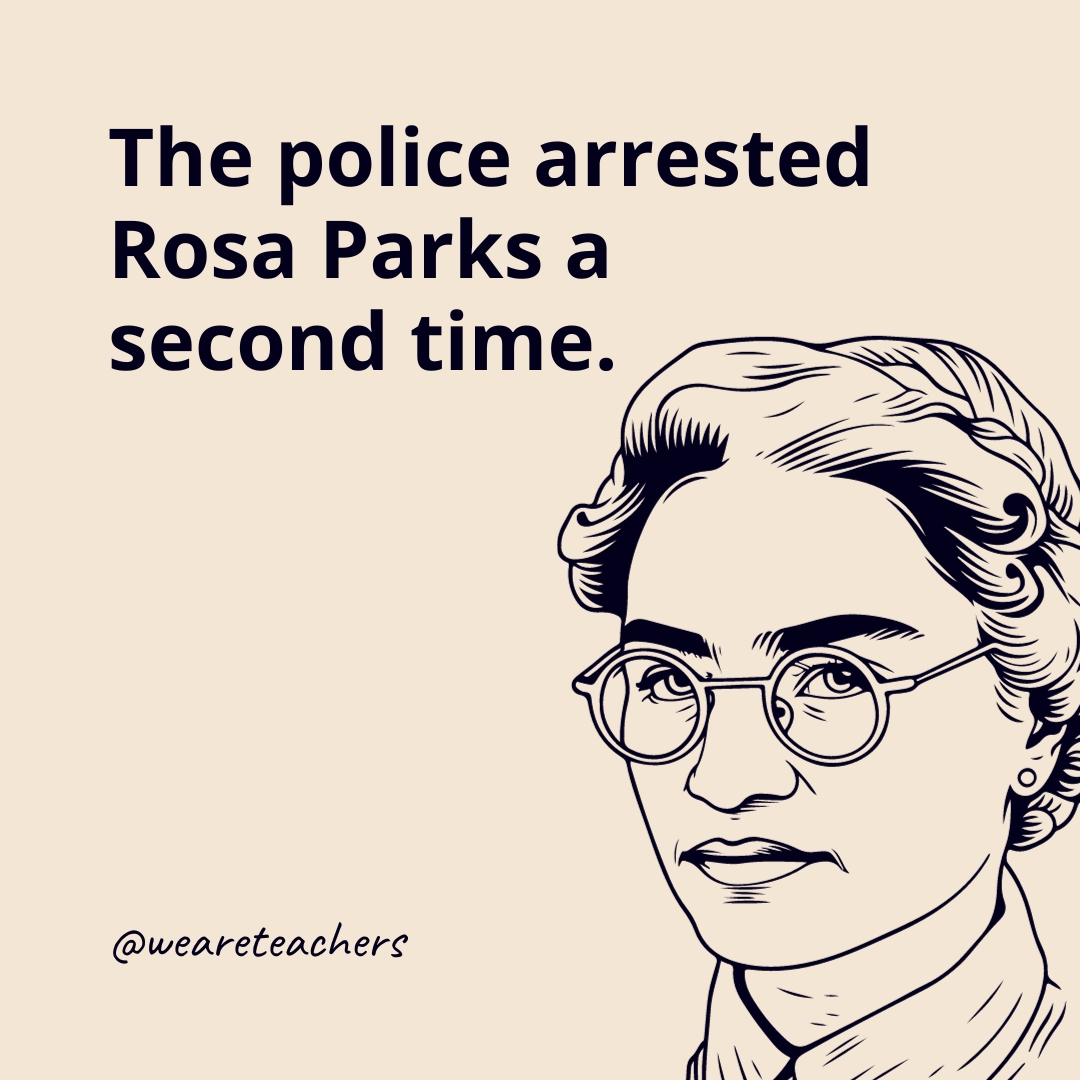
On February 22, 1956, 114 protesters, including Parks and Dr. Martin Luther King Jr., were arrested for challenging bus segregation laws. The high-profile arrest put a media spotlight on the boycott, which ultimately helped the movement.
Source: Equal Justice Initiative
Rosa Parks lost her job.
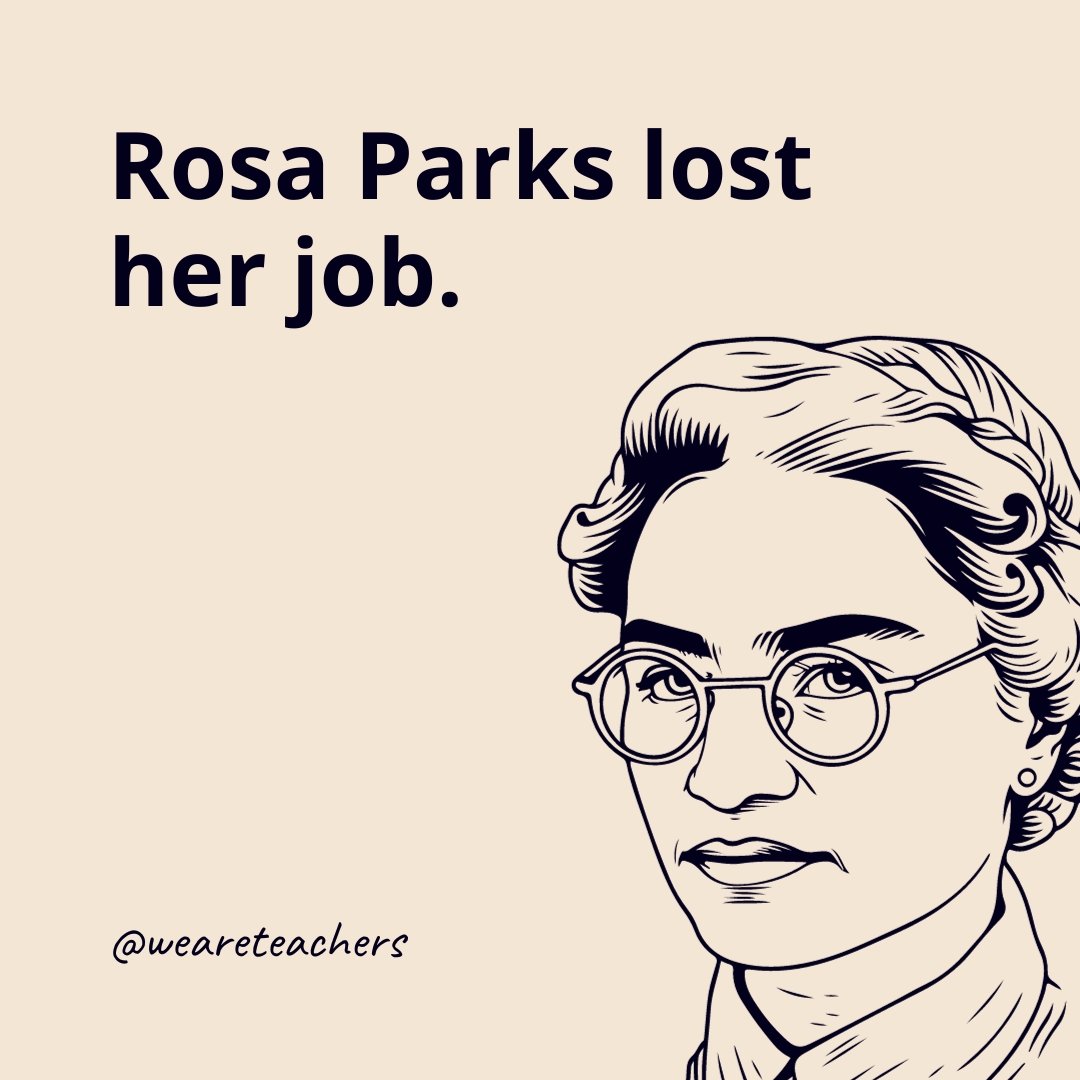
Parks worked as a seamstress at the Montgomery Fair department store but was fired after her arrest. Her employers claimed, however, that it was not because of the boycott. Her husband lost his job as well.
Rosa Parks and her husband received death threats.
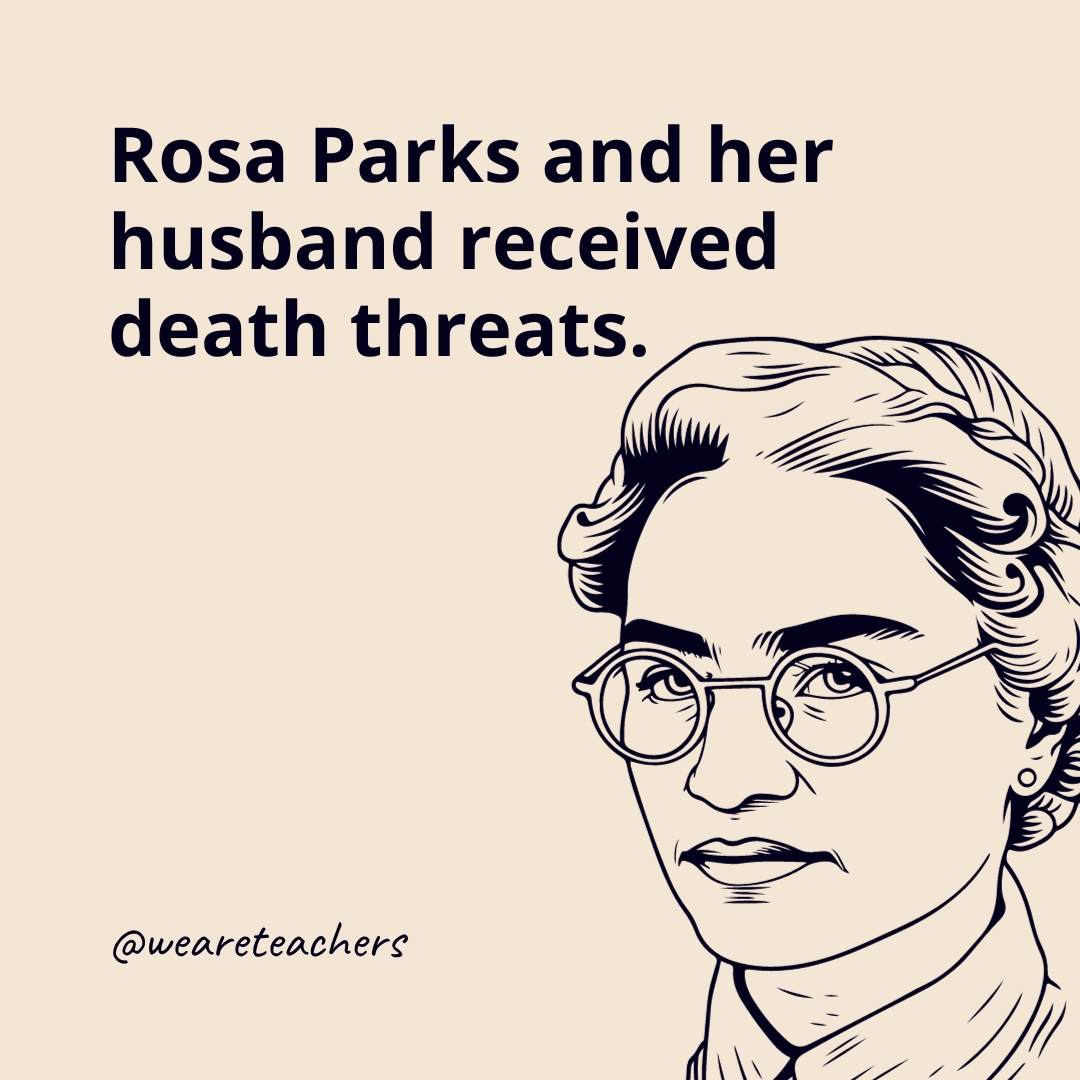
After receiving endless phone calls and death threats, Rosa and Raymond Parks, along with her mother, moved to Detroit in 1957.
Source: National Park Service
Rosa Parks remained involved in activism throughout her life.
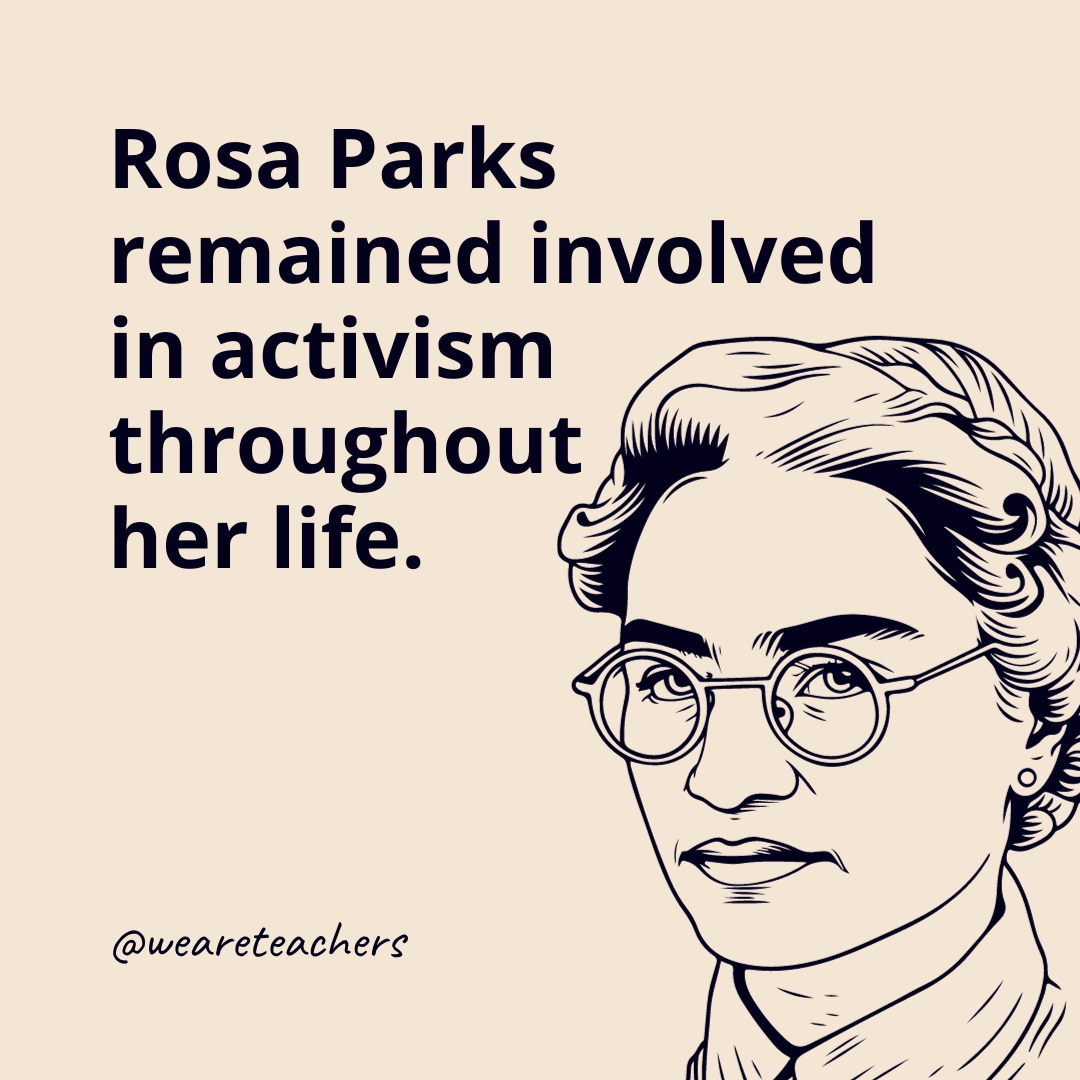
Parks participated in the Prayer Pilgrimage for Freedom, the March on Washington for Jobs and Freedom, and the Selma-to-Montgomery March, and she worked in Congressman John Conyers’ district office and even served on the board of Planned Parenthood.
The NAACP awarded Rosa Parks the Spingarn Medal.
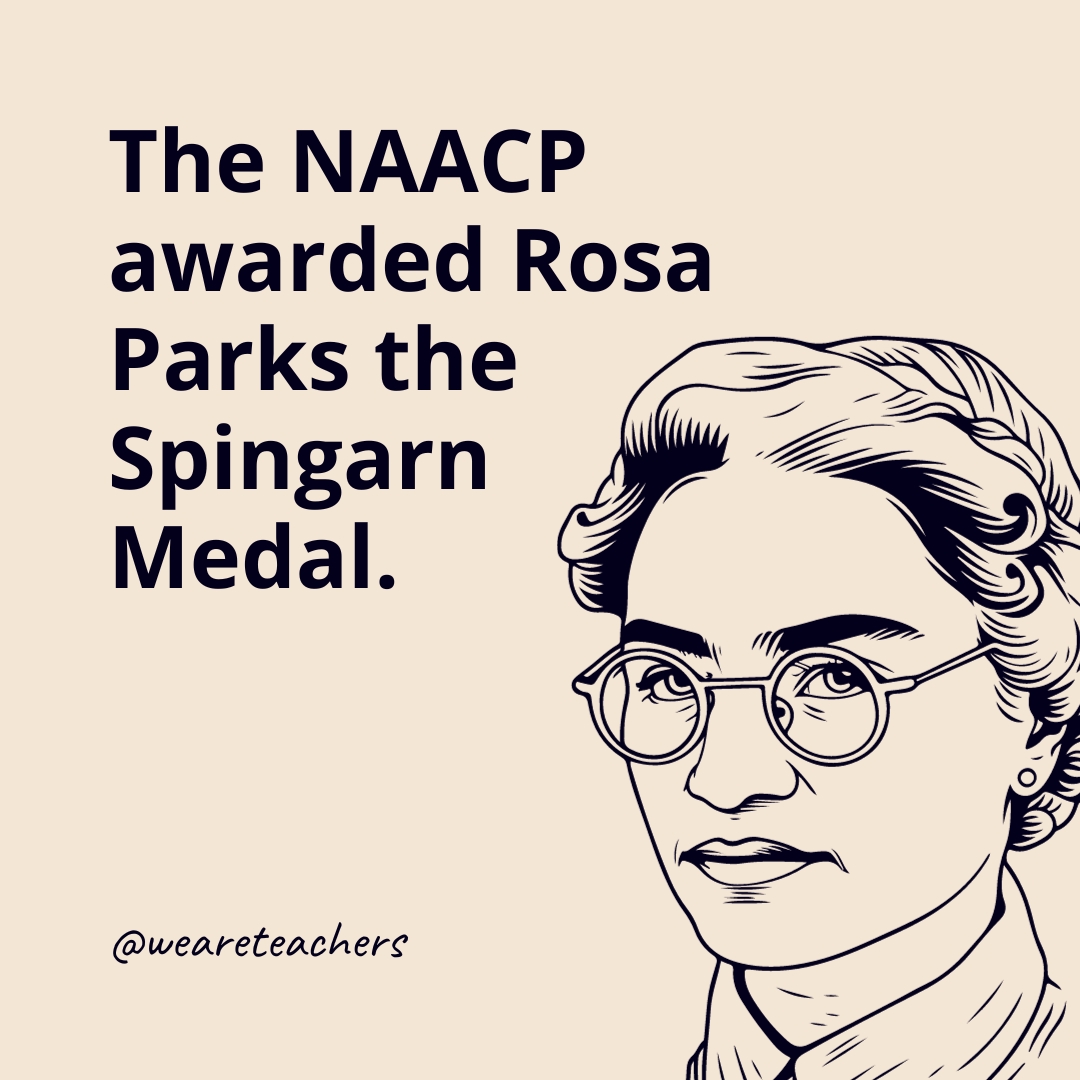
Rosa Parks was awarded the Spingarn Medal in 1979. As described when this award was founded, this honor is “the man or woman of African descent and American citizenship who shall have made the highest achievement during the preceding year or years in any honorable field.”
Source: Britannica
Rosa Parks founded the Rosa and Raymond Parks Institute.
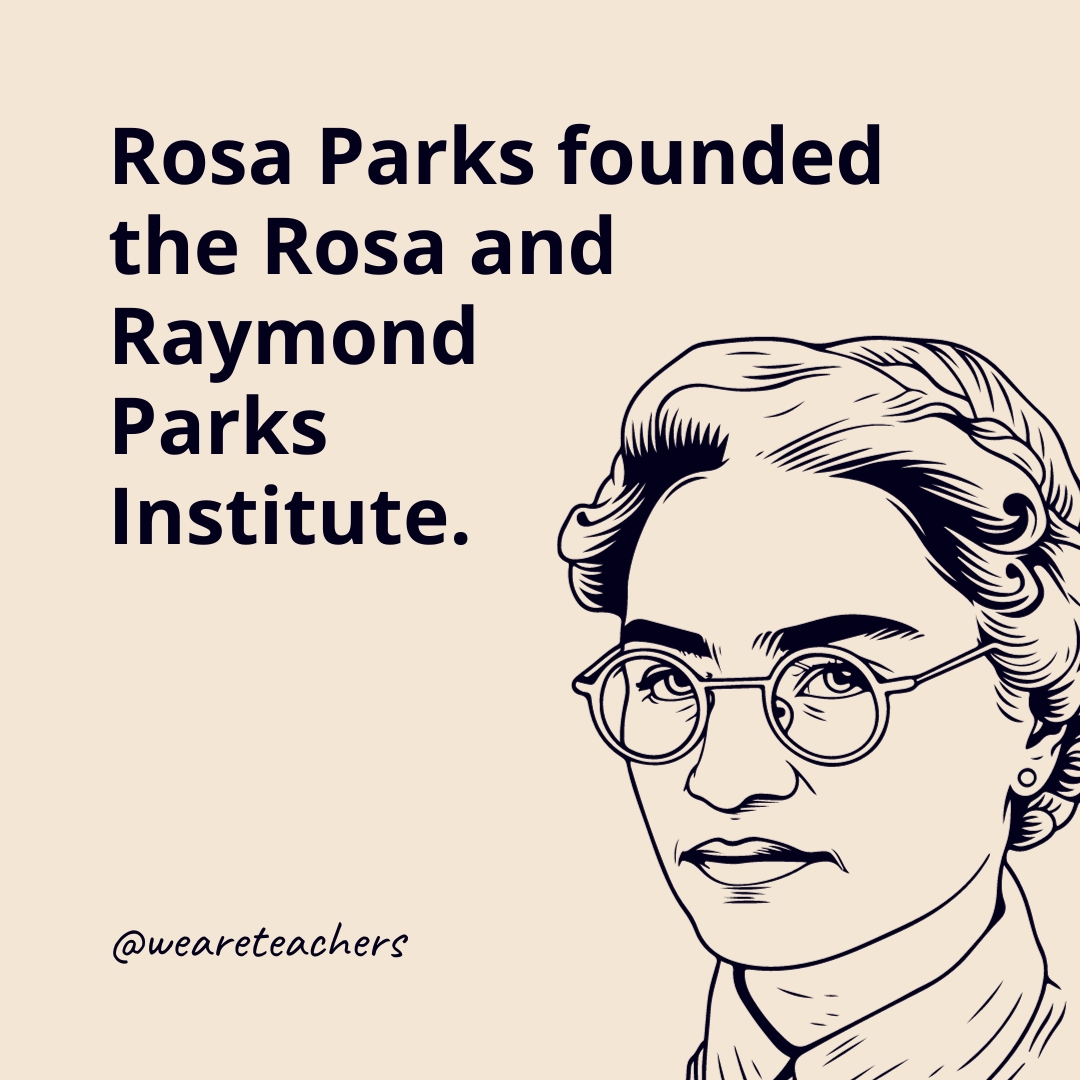
In 1987, the institute was established “to carry on the lifework of Rosa Parks in youth development and civil rights education/advocacy.”
Source: Rosa and Raymond Parks Institute
Rosa Parks was a published author.
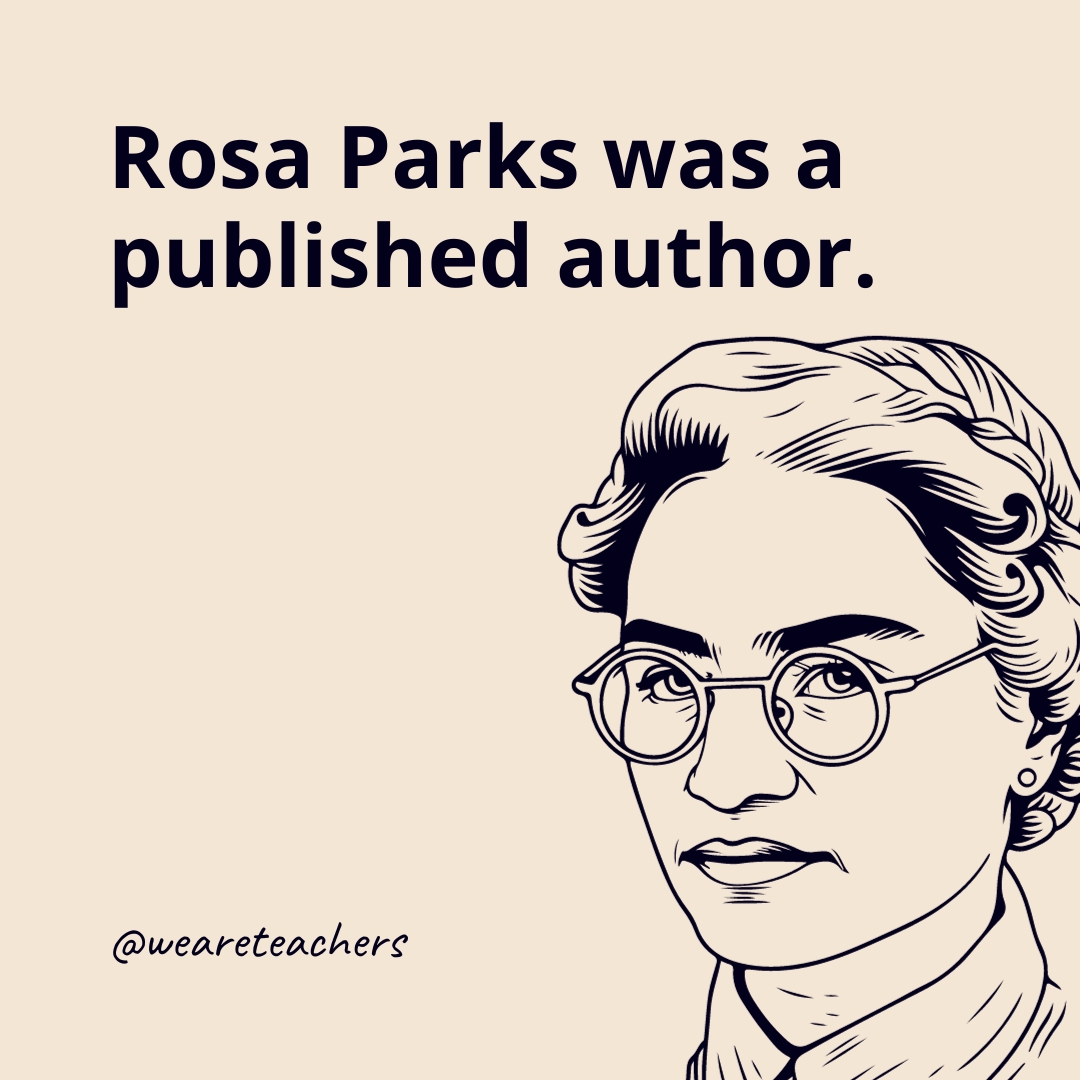
Parks co-authored Rosa Parks: My Story , Quiet Strength: The Faith, the Hope, the Heart of a Woman Who Changed a Nation , and Dear Mrs. Parks: A Dialogue With Today’s Youth .
Rosa Parks filed a lawsuit against hip-hop duo Outkast.
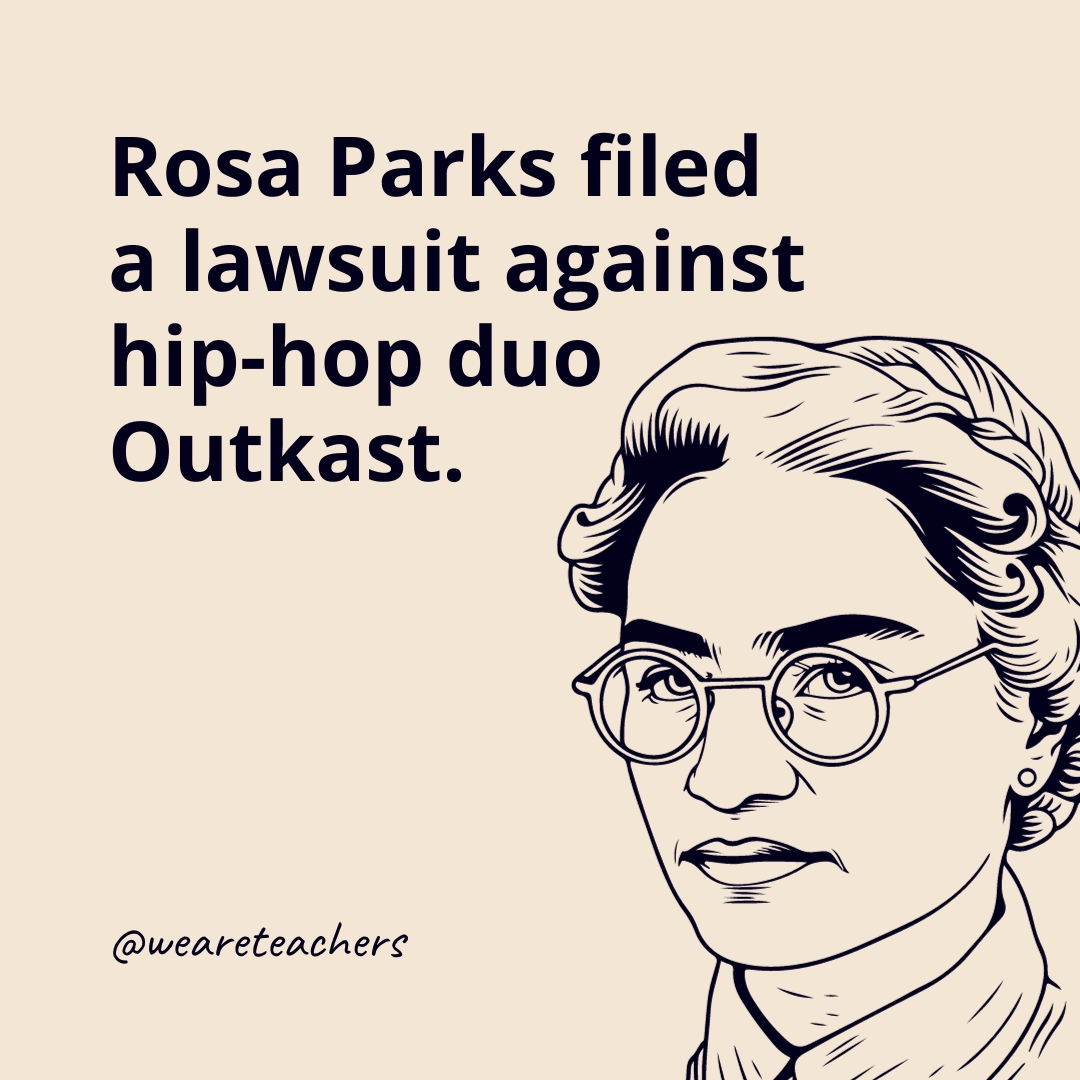
After Outkast released a song titled “Rosa Parks,” Parks argued defamation and false advertising. The 1998 track included the lyrics “Ah-ha, hush that fuss. Everybody move to the back of the bus.” Outkast defended themselves citing the First Amendment. The case was settled seven years later when the group agreed to help create educational programs for youth with the Rosa and Raymond Parks Institute.
Source: Biography
President Clinton awarded Rosa Parks the Presidential Medal of Freedom.

President Bill Clinton awarded Parks this highest honor given by the United States executive branch.
Source: Clinton Digital Library
Congress awarded Rosa Parks the Congressional Gold Medal.
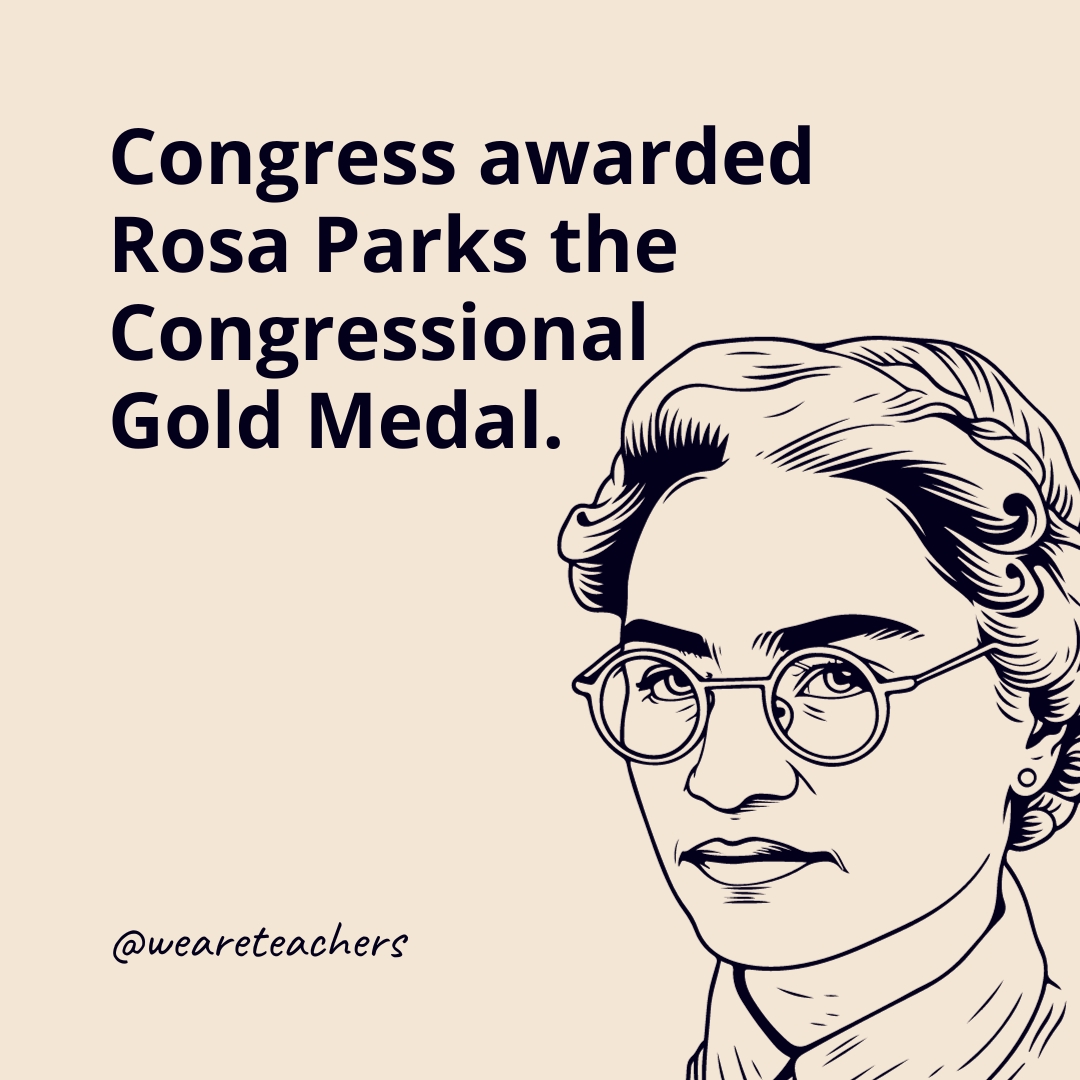
This is the U.S. legislative branch’s highest award.
Rosa Parks was the first woman to lie in honor in the nation’s Capitol Rotunda.

Following her death on October 24, 2005, in Detroit, Michigan, Rosa Parks lie in honor in the Rotunda of the Capitol. She was the first woman and only the second person of color to receive that honor.
Source: U.S. Capitol Visitors Center
Also check out these 15 Books About Racial Justice for Kids .
For more content like this, be sure to subscribe to our newsletters ..

You Might Also Like

17 Important Facts About Pearl Harbor for Students of All Ages
Pearl Harbor Day falls on December 7th Continue Reading
Copyright © 2023. All rights reserved. 5335 Gate Parkway, Jacksonville, FL 32256
ROSA PARKS' BIOGRAPHY
A resource for teaching rosa parks.
The impetus for this website came from three directions. First, Rosa Parks is one of the most well-known Americans of the 20th century. She is studied in classes throughout the country. But much of what is easily accessible on the web about her biography distorts and diminishes her “life history of being a rebel,” as she put it, missing her decades of political work before the boycott and almost completely ignoring her forty years of life and activism in Detroit. So one goal of this website is to provide a fuller and more accurate history for people to teach and learn about Rosa Parks–her life, her beliefs, and her six decades of political work in Montgomery and Detroit.
The second motivation came from current struggles for racial justice today, particularly the Black Lives Matter movement. One of the through-lines in Rosa Parks’ six decades of activism was her resolve to change and challenge the injustices endemic in the criminal justice system. Yet this part of her work–and the civil rights movement more broadly–is not often acknowledged in popular accounts of the struggle. So the “read the story” section tells Rosa Parks’ history though criminal justice, showing the continuities of injustice, criminalization, and sustained struggle between the efforts of civil rights activists during the 1950s-1970s and movements challenging mass incarceration, police brutality, and government repression today.
The third impetus came from a grant through the Mellon Seminar for Public Engagement and Collaborative Research of the Center for the Humanities at the CUNY Graduate Center. This support provided us the time, space and encouragement to think about how to change how we teach and learn about Rosa Parks and make Rosa Parks’ full history more publicly known and accessible.
The site is the product of a yearlong collaboration between Jeanne Theoharis, Say Burgin, and Jessica Murray. It draws on numerous archival sources, particularly Rosa Parks’ papers held at the Walter Reuther Library at Wayne State University and at the Library of Congress , as well as The Rebellious Life of Mrs. Rosa Parks .
Jeanne Theoharis is Distinguished Professor of Political Science at Brooklyn College of City University of New York and the author or co-author of seven books and numerous articles on the civil rights and Black Power movements, the politics of race and education, social welfare and civil rights in post-9/11 America. Her widely acclaimed biography The Rebellious Life of Mrs. Rosa Parks won a 2014 NAACP Image Award and the Letitia Woods Brown Award from the Association of Black Women Historians and was named one of the 25 Best Academic Titles of 2013 by Choice. Her work has appeared in the New York Times , Washington Post , MSNBC , The Nation , The Root , Slate , The Intercept , and the Chronicle of Higher Education .
Say Burgin is Lecturer in American History at the University of Leeds (UK). Her teaching and research interests broadly relate to 20th century African American history, with a particular focus on the women’s liberation and black freedom struggles. She is currently working on a monograph on the myth of white ejection from the Black Power movement and has published in the Journal of American Studies , the Journal of International Women’s Studies , and the Women’s History Review.
Jessica Murray is a doctoral student in Human Development/Psychology at The Graduate Center, CUNY and helped to create this site in her role as a Digital Fellow for the Center for the Humanities at The Graduate Center. Her other interests include mobilities, transportation, technology, disability studies, accessibility, and disability rights. She earned a BFA in Design from the University of Texas at Austin in 2003 and worked as a graphic designer in a variety of media before coming to The Graduate Center in 2012. She completed an MA in Liberal Studies, in the Psychology of Work and Family track in 2014.

Rosa Parks: Biography, Quotes, Impact
On December 1, 1955, in Montgomery, Alabama, a Black woman named Rosa Parks finished her work day and caught a bus home. Segregation was the law of the land in Montgomery, so while the front of the bus was available to white citizens, Black people had to go to the back. When all the white seats were taken, the bus driver told all the Black people they needed to give up their seats to add an extra row for white people. Rosa Parks stayed seated. The police were called and she was arrested. This defiant act sparked a nationwide campaign to end segregation, protect the rights of Black people and usher in a new era of equality and freedom. In this article, we’ll explore who
Rosa Parks was, what she had to say about her activism and beliefs, and the impact she had on the United States.
By refusing to give up her seat on a segregated bus, Rosa Parks is known as “the mother of the Civil Rights Movement.” Her decision sparked campaigns around the country, which eventually led to the Civil Rights Act of 1964 and Voting Rights Act of 1965.
Who was Rosa Parks and what did she do?
Rosa Parks was born Rosa McCauley on February 4, 1913. She received her early education at a private school, but while caring for both her grandmother and mother, Rosa had to delay completing her high school credits. In 1932, she married Raymond Parks and then received her high school diploma in 1934. Raymond had less formal education than Rosa, but was an extremely intelligent, activism-minded individual. Both Rosa and Raymond worked with the National Association for the Advancement of Colored People (NAACP).
In 1955, Rosa was arrested for refusing to give up her bus seat. Anti-segregation activists organized a boycott of Montgomery buses for the day of Rosa’s trial. She was given a suspended sentence and a fine, but the boycott was more successful than anticipated. Activists decided to keep boycotting the bus system, electing Martin Luther King Jr., who had just arrived in the city, as the boycott’s manager. Over 70% of Montgomery’s bus patrons were Black, so the impact was immediate. To sustain the boycott, 200 people volunteered their cars while 100 pickup stations were established. Churches also held fundraisers to fund the carpool. On November 13th, 1956, after more than a year of the boycott, the U.S. Supreme Court ruled that bus segregation was unconstitutional.
Systemic racism is still a problem in the United States. Check out our article of 10 examples .
What happened to Rosa Parks after the boycott?
During the bus boycott, Rosa lost her job and faced severe harassment, including death threats. Things didn’t improve after the boycott’s success, so in 1957, Rosa, her husband, and her mother moved to Detroit, Michigan. As the Civil Rights movement continued, so did Rosa’s activism , despite the personal costs she and her family endured. From 1966 until her retirement in 1988, she worked as an administrative aid in Congressman John Conyers’ office. She also co-founded the Rosa and Raymond Parks Institute for Self-Development. The nonprofit served young people. Rosa and Raymond never had children of their own, but young people were always important to Rosa. Before Rosa’s arrest, 15-year Claudette Colvin had been arrested for refusing to give up her bus seat. This injustice did not spark a boycott, but Rosa reached out to Claudette. For a while, they were close .
In 1999, Rosa was awarded the Congressional Gold Medal, the highest honor a US civilian can earn. She received many other awards and honorary doctorates from universities around the world. In 2000, Troy University in Montgomery, Alabama established the Rosa Parks Library and Museum. In 2005, Rosa died at age 92. She became the first woman in American history to lie in honor at the Capitol.
Learn more about racial justice and anti-racism by taking these online courses .
What are some of Rosa Parks’ best quotes?
Throughout her many years of activism, Rosa Parks offered countless words of wisdom that resonate to this day. Here are five of her most powerful quotes:
“The time had just come when I had been pushed as far as I could stand to be pushed, I suppose. They placed me under arrest. And I wasn’t afraid. I don’t know why I wasn’t, but I didn’t feel afraid. I had decided that I would have to know once and for all what rights I had as a human being and a citizen, even in Montgomery, Alabama.”
This quote comes from a 1956 radio interview with Rosa Parks, which is one of the earliest interviews she gave. Democracy Now uploaded the audio, as well as a transcript . In this quote, Parks recalls her protest and her lack of fear despite being arrested. The phrase “even in Montgomery, Alabama” is especially striking as it shows the severity of racism and discrimination in that era.
“As I look back on those days, it’s just like a dream. The only thing that bothered me was that we waited so long to make this protest and to let it be known wherever we go that all of us should be free and equal and have all opportunities that others should have.”
Found on Digital History, this quote comes from a 1995 interview with the iconic activist. In the interview, she reflected on her protest and arrest. When asked if she remembers feeling anger as she chose to not give up her bus seat, she recalls feeling determination, not anger. She wanted to take the opportunity to make it clear she was not going to be treated poorly and that people had endured such treatment for too long.
“I would like to be remembered as one who has always cared for people. I have more concern for people than material things. I have always wanted to help people.”
The Library of Congress has a collection of Rosa Parks’ papers, and among them is a 1975 interview with a college student. The interviewer asks Parks how she wants to be remembered. The activist gives a simple, but powerful answer consistent with the values Parks’ lived with her whole life. She was never someone who sought fame or attention. While her refusal to give up her bus seat is regarded as the spark for the Civil Rights Movement, she never used her position to gain more power. She just wanted to care for people.
“As long as people use tactics to oppress or restrict other people from being free, there is work to be done. Although we made many gains, racism is still alive.”
In 1994, Rosa Parks wrote a book with Gregory J. Reed called Quiet Strength. Published by Zondervan and reprinted as Reflections by Rosa Parks , it offers a series of reflections from the activist on topics like fear, injustice, faith and the future. The quote above, which is from the chapter on injustice, acknowledges the progress made, as well as the progress still needed to secure the freedom and equality of all. While Parks spoke of racism specifically, her remarks apply to all forms of oppression.
“It is better to teach – and live – equality and love than it is to teach hatred.”
In Reflections , Rosa Parks discusses her concern about racial violence and white supremacy on college campuses. However, she expresses hope and a belief that teaching and living out the values of equality and love is better than teaching hatred. She doesn’t want to dwell “on the horrors of the past.” That doesn’t mean she doesn’t want people learning about the past, of course; she encourages young people to learn their history. She wants people to focus on equality and love while doing so.
Interested in more quotes about activism, social justice and human rights? Check out this article.
What impact did Rosa Parks have on the world?
Rosa Parks has been called “the mother of the Civil Rights Movement.” While the fight against racial segregation had been building for years, her decision sparked a massive wave of activism and support not seen before. Her quiet defiance gave the movement something concrete to mobilize around. What was unique about her? Parks was always a humble woman, but Martin Luther King Jr. said it was because “her character was impeccable and her dedication deep-rooted.” Everyone respected her.
The success of the bus boycott turned the tide for Black people in America. President John F. Kennedy introduced the Civil Rights Act of 1964 but was assassinated before it could be made a reality. His successor, President Lyndon B. Johnson, signed the bill into law . What did it achieve? It banned discrimination based on race, color, religion or national origin in public facilities, which ended the Jim Crow system. It also made discrimination in hiring practices illegal and established the Equal Employment Opportunity Commission, which is responsible for enforcing the law. The law wasn’t perfect, however. It didn’t address voting rights. In 1965, Martin Luther King, Jr. led a march from Selma to Montgomery to draw attention to this error. They were met with fierce and often violent opposition, but the march successfully increased support for the Voting Rights Act. In August of that year, Johnson signed the act into law. Rosa Parks was among those at the event. What began as the simple act of refusing to give up her seat led to the end of legalized racial segregation and discrimination.
You may also like

12 Ways Poverty Affects Society

15 Great Charities to Donate to in 2024

15 Quotes Exposing Injustice in Society

14 Trusted Charities Helping Civilians in Palestine

The Great Migration: History, Causes and Facts

Social Change 101: Meaning, Examples, Learning Opportunities

Top 20 Issues Women Are Facing Today

Top 20 Issues Children Are Facing Today

15 Root Causes of Climate Change

15 Facts about Rosa Parks

Abolitionist Movement: History, Main Ideas, and Activism Today

The Biggest 15 NGOs in the UK
About the author, emmaline soken-huberty.
Emmaline Soken-Huberty is a freelance writer based in Portland, Oregon. She started to become interested in human rights while attending college, eventually getting a concentration in human rights and humanitarianism. LGBTQ+ rights, women’s rights, and climate change are of special concern to her. In her spare time, she can be found reading or enjoying Oregon’s natural beauty with her husband and dog.

Seamstress, Civil Rights Leader : 1913 – 2005
“the only tired i was, was tired of giving in.”.
Rosa Parks, the matriarch of the civil rights movement, has been described as an old woman who was too tired to give up her seat on a bus to a white person. However, Parks used her autobiography to correct the record. “I was not old, although some people have an image of me as being old then. I was forty-two.” She also made it clear that “the only tired I was, was tired of giving in.” Parks’s sentiment represented the view of the millions of African Americans, and their allies, who set out to end legal segregation in the mid-1900s.
Parks was born Rosa Louise McCauley, to James McCauley and Leona Edwards McCauley, in Tuskegee, Alabama, on February 4, 1913. Following her parents’ separation, Parks moved with her mother and younger brother to her maternal grandparents’ home in Pine Level, Alabama, just outside of Montgomery. She was educated at Montgomery’s Industrial School for Girls. At age sixteen, Parks suspended her studies to help support her family.
Though Parks was certainly aware of the daily injustices visited upon African Americans through Jim Crow segregation laws, she was not an early activist for racial equality. In 1932, she married Montgomery barber Raymond Parks who was active in the local NAACP chapter. With her husband’s encouragement, Parks completed her high school education in 1933. Parks worked as a seamstress at the Montgomery Fair department store. But it was through a job at Maxwell Air Force Base in Montgomery that Parks got her first taste of integration.
Parks did not join the NAACP until 1943, when she began serving as secretary to E.D. Nixon, who was the Montgomery chapter president from 1943 to 1957. As Nixon’s secretary, Parks had a front row seat to the various indignities faced by Montgomery’s African American community. In the summer of 1955, as Parks became more deeply committed to the civil rights struggle, she attended a training session at the Highlander Folk School (now the Highlander Center) in Monteagle, Tennessee; the Highlander Folk School, which began to train labor activists, served as a training ground for civil rights activists, including Martin Luther King, Jr . By year’s end, Parks was able to put to use some of the training she’d received in Monteagle.
On December 1, 1955, following her day of work at Montgomery Fair department store, Parks boarded a city bus and took her seat in the “colored” section. As the number of white passengers grew, the bus driver came to the “colored” section (which was determined with the use of a moveable sign placed in the aisle) to move the sign so as to increase the number of seats available to white passengers. It was at that point that Parks decided that she was not going to get up and move to a row behind her. The bus driver called the police, and Parks was arrested for violating Montgomery’s segregation laws.
By December 4, 1955, plans were in place for a one day boycott of the Montgomery city buses. Parks’s trial was December 5, the same day as the one day boycott; she was found guilty of disorderly conduct and violating Montgomery’s segregation law. The boycott, however, was an overwhelming success, because the vast majority of Montgomery’s African American community participated. It led to the creation of the Montgomery Improvement Association (MIA), and a young Martin Luther King, Jr. , was elected as the association’s president. Ultimately, the MIA extended the boycott and the the African American community of Montgomery stayed off city buses until December 20, 1956, following the U.S. Supreme Court ruling in Browder v. Gayle , which affirmed a lower court’s ruling that segregated seating on public buses was unconstitutional.
Parks’s arrest took a toll on the Parks family; both Rosa and Raymond Parks ended up unemployed (through a firing and a resignation, respectively). The Parks left Montgomery for Hampton, Virginia in 1957, and then relocated permanently to Detroit, Michigan, where Parks found work as a seamstress. However, following the election of John Conyers to the U.S. House of Representatives, Parks was offered a position as receptionist and secretary in Conyers’ Detroit office. Parks remained with the congressman’s office until her retirement in 1988.
In 1980, following the deaths of her husband (1977), brother (1977) and mother (1979), Parks, along with The Detroit News , and the Detroit Public school system, founded the Rosa L. Parks Scholarship Foundation. Parks also co-founded, with Elaine Steele, the Rosa and Raymond Parks Institute for Self Development in 1987. Both organizations remain active, and continue to uphold the legacy of Parks.
Parks’s place in the history of the civil rights movement has been recognized and honored by the nation. She was awarded the Presidential Medal of Freedom in 1996, as well as the Congressional Gold Medal in 1999, for her role in the civil rights movement.
At the age of ninety-two, she passed away in Detroit. President George W. Bush ordered all U.S. flags to be flown at half-staff in her honor. Parks was also given the honor of lying in state in the rotunda of the U.S. Capitol. She was the first woman and the second African American to lie in state. On February 27, 2013, a statue of Parks was unveiled in the National Statuary Hall in the U.S. Capitol; that statue had been requested by President Bush on December 1, 2005, the 50th anniversary of Parks’s arrest.
Americans Who Tell the Truth (AWTT) offers a variety of ways to engage with its portraits and portrait subjects. Host an exhibit, use our free lesson plans and educational programs, or engage with a member of the AWTT team or portrait subjects.

AWTT has educational materials and lesson plans that ask students to grapple with truth, justice, and freedom.

Exhibits & Community Engagement
AWTT encourages community engagement programs and exhibits accompanied by public events that stimulate dialogue around citizenship, education, and activism.
Contact Us to Learn How to Bring a Portrait Exhibit to Your Community.
We are looking forward to working with you to help curate your own portrait exhibit. contact us to learn about the availability of the awtt portraits, rental fees, space requirements, shipping, and speaking fees. portraits have a reasonable loan fee which helps to keep the project solvent and accessible to as many people as possible. awtt staff is able help exhibitors to think of creative ways to cover these expenses., americans who tell the truth, hear updates from awtt.
Learn more about our programs and hear about upcoming events to get engaged.
Help Support AWTT
Your donations to AWTT help us promote engaged citizenship. Together we will make a difference.
© 2024 Americans Who Tell The Truth
- Terms of Use
- Privacy Policy
Bring Americans Who Tell the Truth (AWTT) original portraits to your community.

- Occupation: Civil Rights Activist
- Born: February 4, 1913 in Tuskegee, Alabama
- Died: October 24, 2005 in Detroit, Michigan
- Best known for: Montgomery Bus Boycott

- Rosa was awarded the Congressional Gold Medal as well as the Presidential Medal of Freedom.
- Rosa often worked as a seamstress when she needed a job or to make some extra money.
- You can visit the actual bus that Rosa Parks sat in at the Henry Ford Museum in Michigan.
- When she lived in Detroit, she worked as a secretary for U.S. Representative John Conyers for many years.
- She wrote an autobiography called Rosa Parks: My Story in 1992.
- Listen to a recorded reading of this page:
Back to Biography for Kids
The Mother of Civil Rights
# Summary: A Biography of Rosa Parks
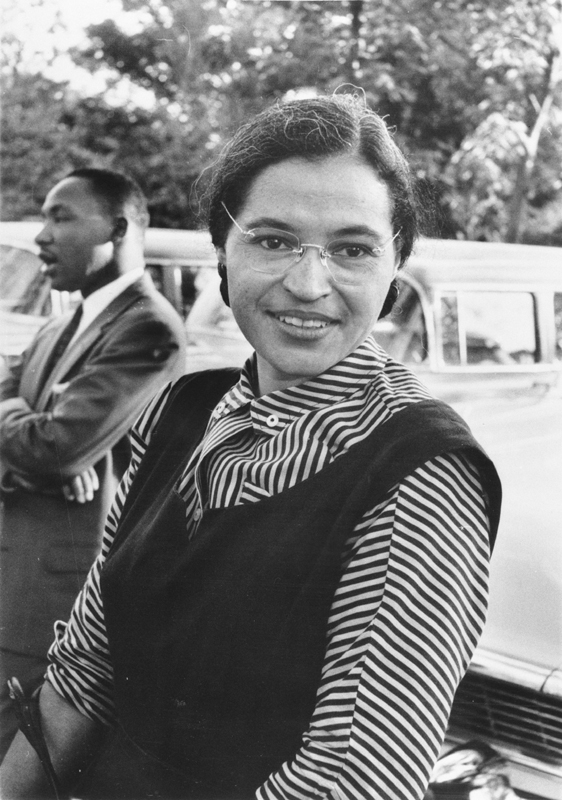
Rosa Parks, named “The Mother of the Modern-Day Civil Rights Movement”, was an African-American woman born in Tuskegee, Alabama in 1913. She is most well known for her stand against racial segregation on public buses in Montgomery, Alabama. Rosa refused to give up her seat for a white man and was arrested, charged with, and convicted of civil disobedience. Rosa spent most of her life fighting for desegregation, voting rights, and was active in the Civil Rights movement that has shaped social code in the Unites States. No matter what city she lived in, she found a way to stay involved in the community and always seemed to have a way to voice her thoughts and feelings about inequalities in society. Rosa had a knack for doing this effectively, but quietly and was known for her saying, “Do what is right.”
Within the span of her 92 years of life, Rosa has been actively peered by the most influential leaders in black American history. She has been presented with numerous awards for her contribution in forging positive change in a time when social inequality was commonplace.
Early Years →

IMAGES
VIDEO
COMMENTS
Rosa Parks (born February 4, 1913, Tuskegee, Alabama, U.S.—died October 24, 2005, Detroit, Michigan) was an American civil rights activist whose refusal to relinquish her seat on a public bus precipitated the 1955-56 Montgomery bus boycott in Alabama, which became the spark that ignited the civil rights movement in the United States.
Rosa Parks gets fingerprinted after her arrest in Montgomery, Alabama, on December 1, 1955. After a long day's work at a Montgomery department store, where she worked as a seamstress, Parks ...
Rosa Louise McCauley Parks (February 4, 1913 - October 24, 2005) was an American activist in the civil rights movement best known for her pivotal role in the Montgomery bus boycott.The United States Congress has honored her as "the first lady of civil rights" and "the mother of the freedom movement".. Parks became an NAACP activist in 1943, participating in several high-profile civil rights ...
Rosa Parks (1913—2005) helped initiate the civil rights movement in the United States when she refused to give up her seat to a white man on a Montgomery, Alabama bus in 1955. Her actions ...
Mrs. Parks was born Rosa Louise McCauley, February 4, 1913 in Tuskegee, Alabama. She was the first child of James and Leona Edwards McCauley. Her brother, Sylvester McCauley, now deceased, was born August 20, 1915. Later, the family moved to Pine Level, Alabama where Rosa was reared and educated in the rural school.
9. Parks was the first woman to lie in honor at the U.S. Capitol. After Parks died at age 92 on October 24, 2005, she received a final tribute when her body was brought to the rotunda of the U.S ...
Rosa Louise McCauley was born on February 4th, 1913 in Tuskegee, Alabama. As a child, she went to an industrial school for girls and later enrolled at Alabama State Teachers College for Negroes (present-day Alabama State University). Unfortunately, Parks was forced to withdraw after her grandmother became ill.
April 14, 2005: Parks and the hip-hop group Outkast reach an out-of-court settlement regarding their 1998 song "Rosa Parks." October 24, 2005: Parks dies at the age of 92
Rosa Parks called Malcolm X her hero, and they interacted several times during the American civil rights movement. Rosa Parks was a lifelong activist, as was her husband. Rosa Parks was not the first black woman to refuse to move from her bus seat; Claudette Colvin had done the same nine months earlier, and countless women had before that. ...
Rosa Parks, the "Mother of the Civil Rights Movement" was one of the most important citizens of the 20th century. Mrs. Parks was a seamstress in Montgomery, Alabama when, in December of 1955, she refused to give up her seat on a city bus to a white passenger. The bus driver had her arrested. She was tried and convicted of violating a local ordinance. Her act sparked a citywide boycott of the ...
Rosa Parks was born on February 4, 1913. On December 1, 1955, she boarded a city bus in Montgomery, Alabama and sat in the middle, where Black passengers in that city were allowed to sit unless a white person wanted the seat. As the bus filled with new riders, the driver told Parks to give up her seat to a white passenger.
Full name: Rosa Louise McCauley Parks. Born: 4 February 1913. Hometown: Tuskegee, Alabama, USA. Occupation: Civil rights activist. Died: 24 October 2005. Best known for: The Montgomery Bus Boycott. Rosa was born in the town of Tuskegee in Alabama, a state in southern USA. Her mother was a teacher and her father a carpenter, and she had a little ...
Rosa Parks graduated from high school. Rosa Parks earned her diploma in 1933 when less than 7% of African Americans graduated from high school. She had dropped out to care for her dying grandmother, but after getting married, her husband encouraged her to return and finish school. Source: Library of Congress.
Here are 11 facts about the Civil Rights icon. #5. Rosa was arrested again in 1956. On February 21, 1956, a Montgomery grand jury indicted Rosa Parks, E.D. Nixon, Martin Luther King Jr, and 86 other people for violating Alabama's Anti-Boycott Act. By participating in the bus boycott, they were technically breaking the law.
About. The impetus for this website came from three directions. First, Rosa Parks is one of the most well-known Americans of the 20th century. She is studied in classes throughout the country. But much of what is easily accessible on the web about her biography distorts and diminishes her "life history of being a rebel," as she put it ...
Rosa Parks became the "Mother of the Modern Day Civil Rights December Movement" 1, 1955 when by defying she transformed racist policies nation defense her human right to dignity and equal treatment. Rosa Alabama Parks on was April and 2, born Rosa Louise former slaves carpenter, and Leona McCauley, a James 1913. daughter McCauley in ...
Rosa Parks: Biography, Quotes, Impact. On December 1, 1955, in Montgomery, Alabama, a Black woman named Rosa Parks finished her work day and caught a bus home. Segregation was the law of the land in Montgomery, so while the front of the bus was available to white citizens, Black people had to go to the back. When all the white seats were taken ...
20 Rosa Parks Facts. Rosa Parks was born in Tuskegee, Alabama, on February 4, 1913. When her parents split, Parks went to live in Pine Level. Rosa married Raymond Parks, a barber from Montgomery, in 1932. In 1943 Rosa Parks joined the Montgomery chapter of the NAACP and became active in the Civil Rights Movement.
Biography. Rosa Parks, the matriarch of the civil rights movement, has been described as an old woman who was too tired to give up her seat on a bus to a white person. However, Parks used her autobiography to correct the record. "I was not old, although some people have an image of me as being old then. I was forty-two.".
Learn about Rosa Parks' biography and her significance in 20th century America. See Rosa Parks facts and view a timeline of major events in her civil rights career. Updated: 11/21/2023
Died: October 24, 2005 in Detroit, Michigan. Best known for: Montgomery Bus Boycott. Biography: Where did Rosa Parks grow up? Rosa grew up in the southern United States in Alabama. Her full name was Rosa Louise McCauley and she was born in Tuskegee, Alabama on February 4, 1913 to Leona and James McCauley.
Summary: A Biography of Rosa Parks. Rosa Parks, named "The Mother of the Modern-Day Civil Rights Movement", was an African-American woman born in Tuskegee, Alabama in 1913. She is most well known for her stand against racial segregation on public buses in Montgomery, Alabama. Rosa refused to give up her seat for a white man and was arrested ...